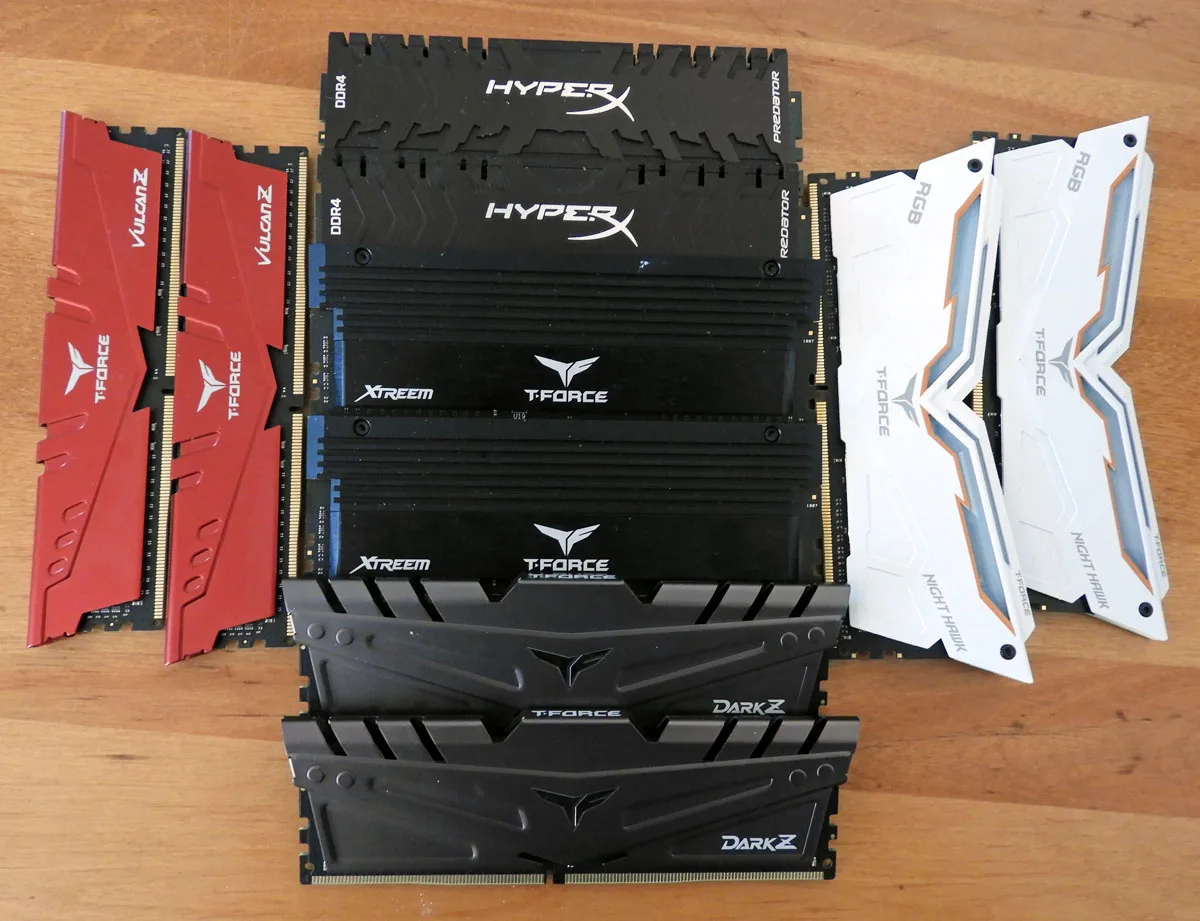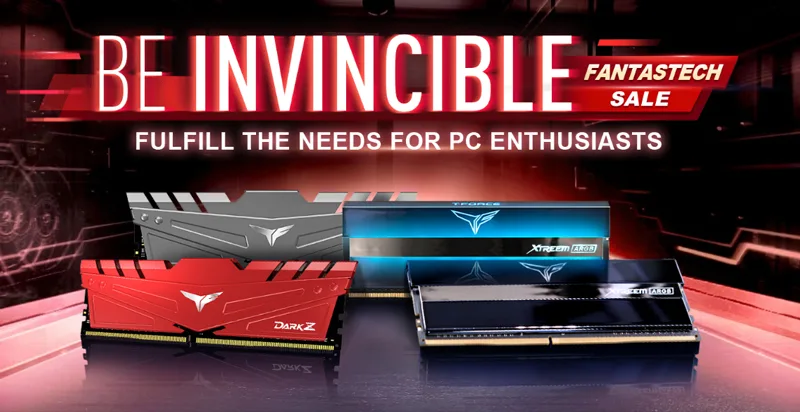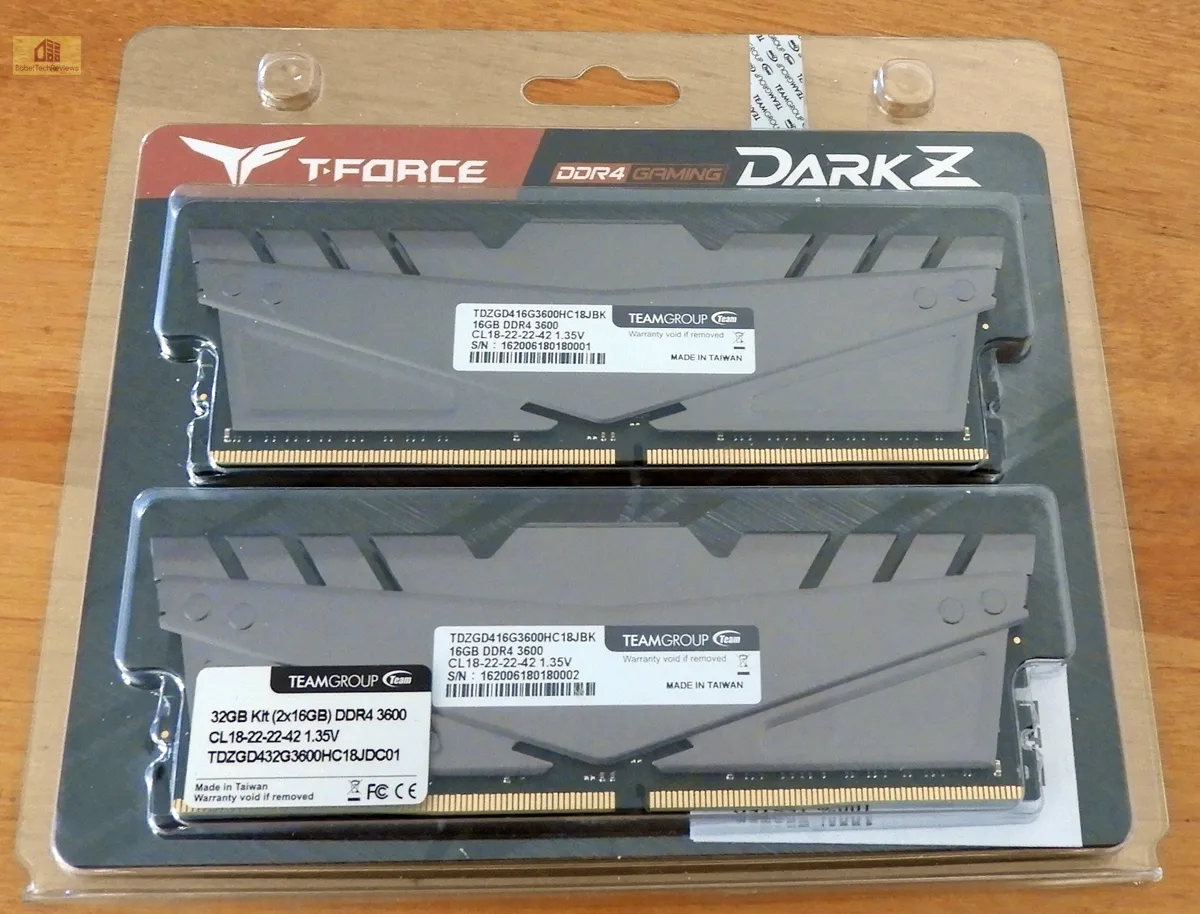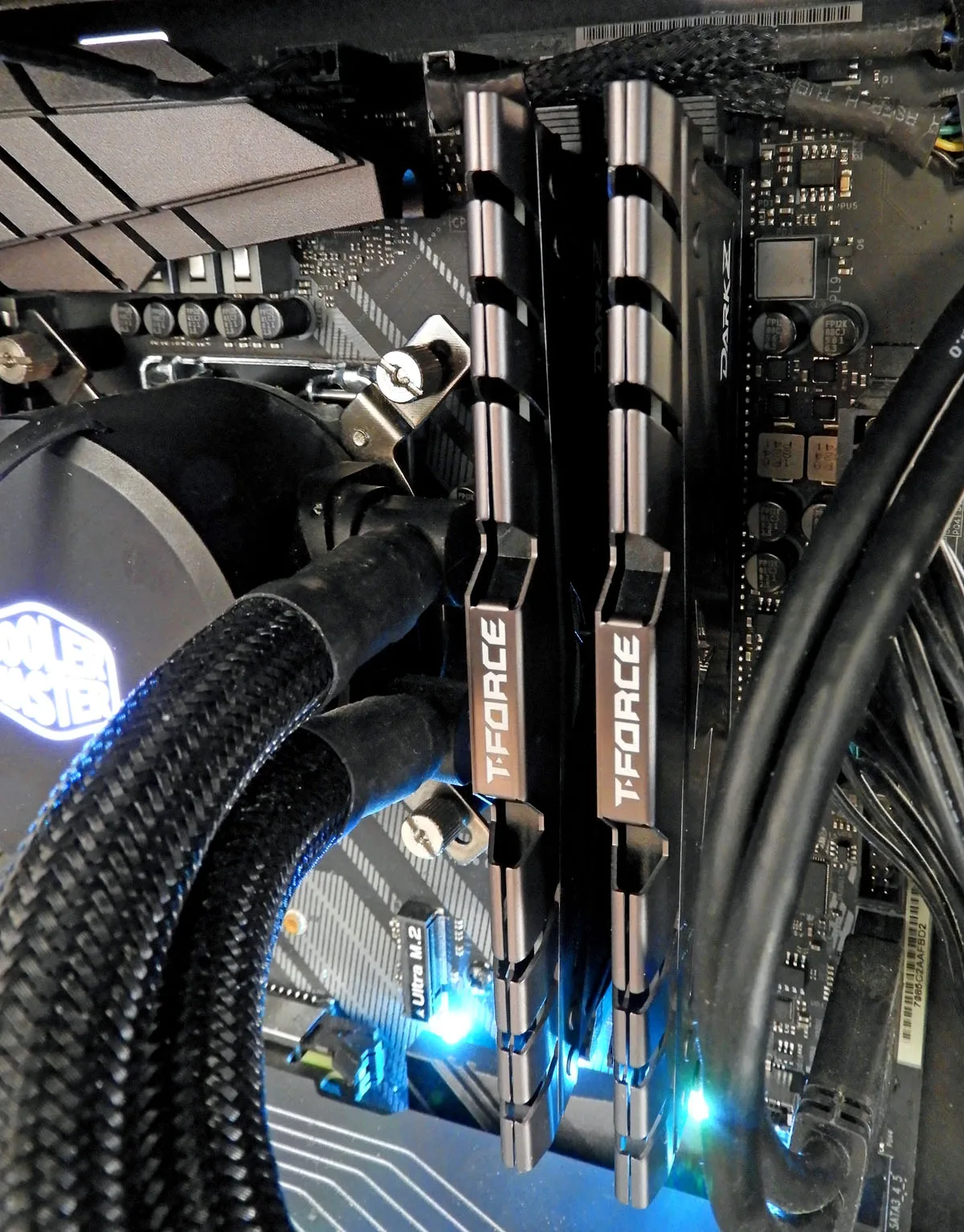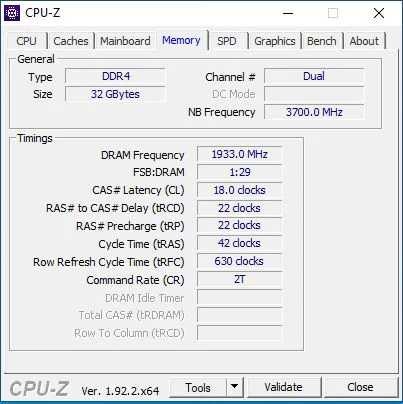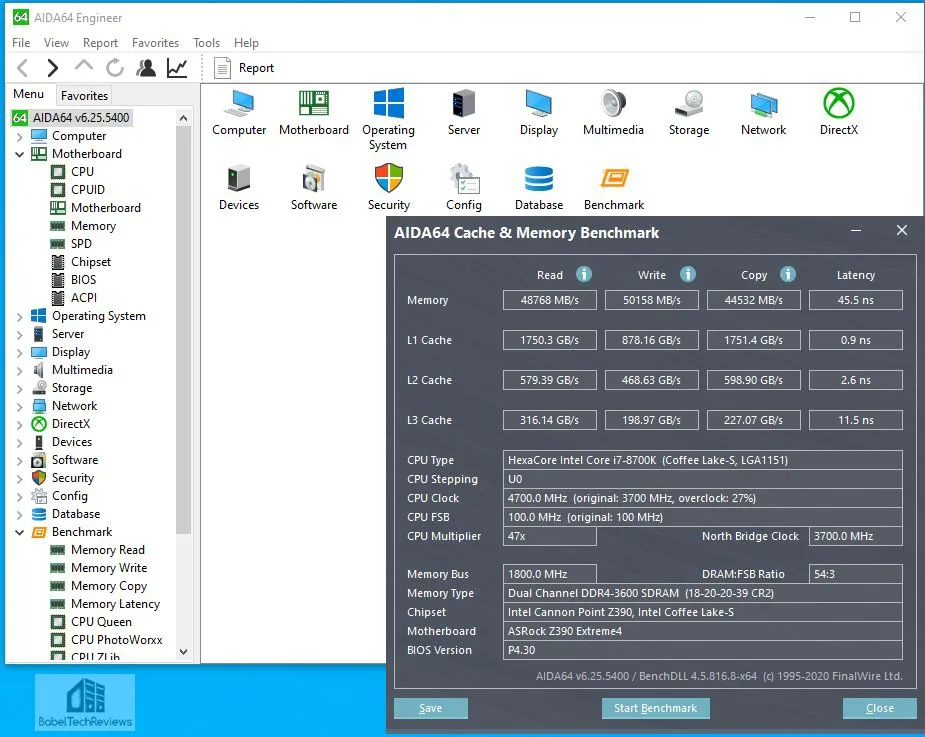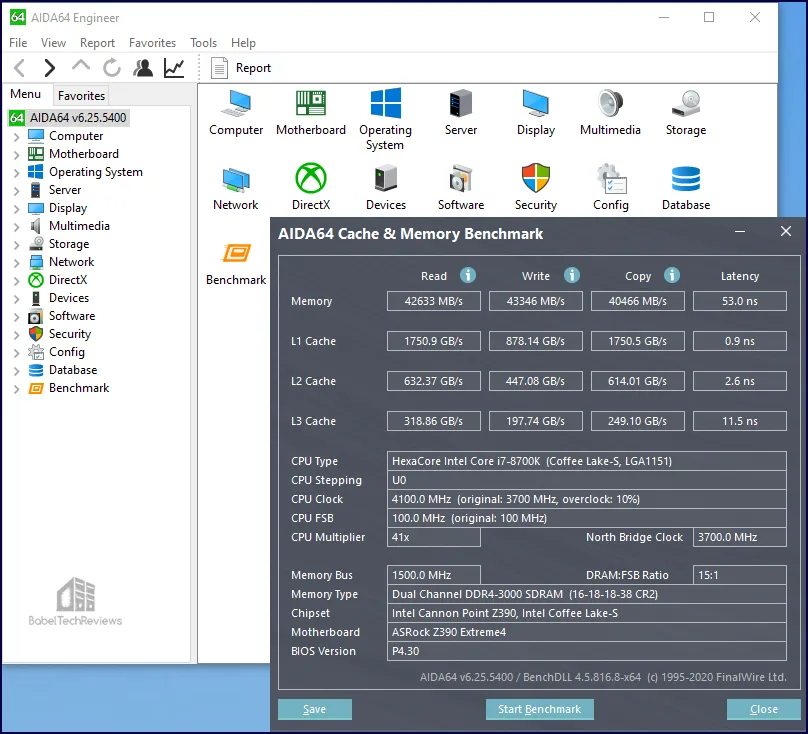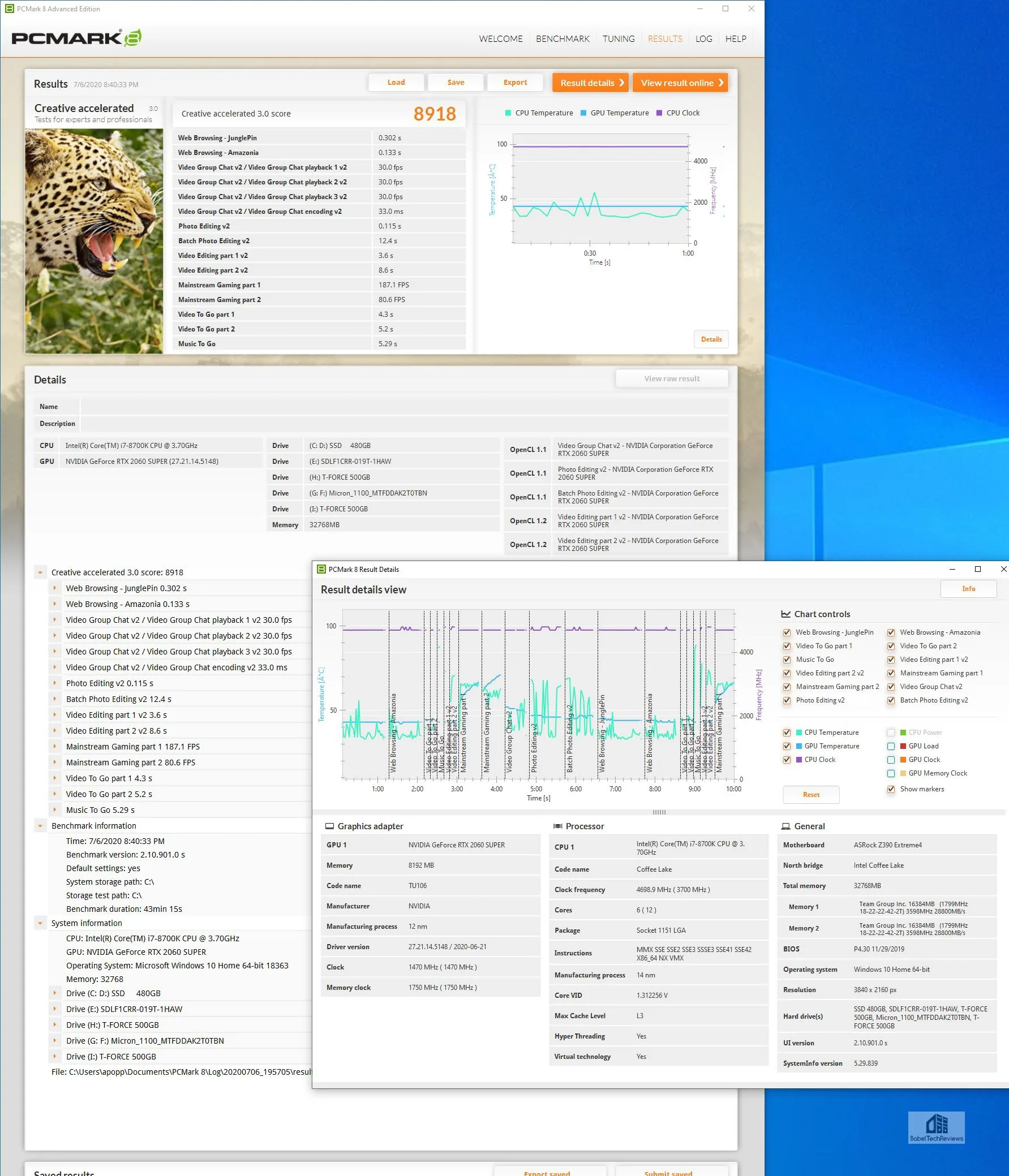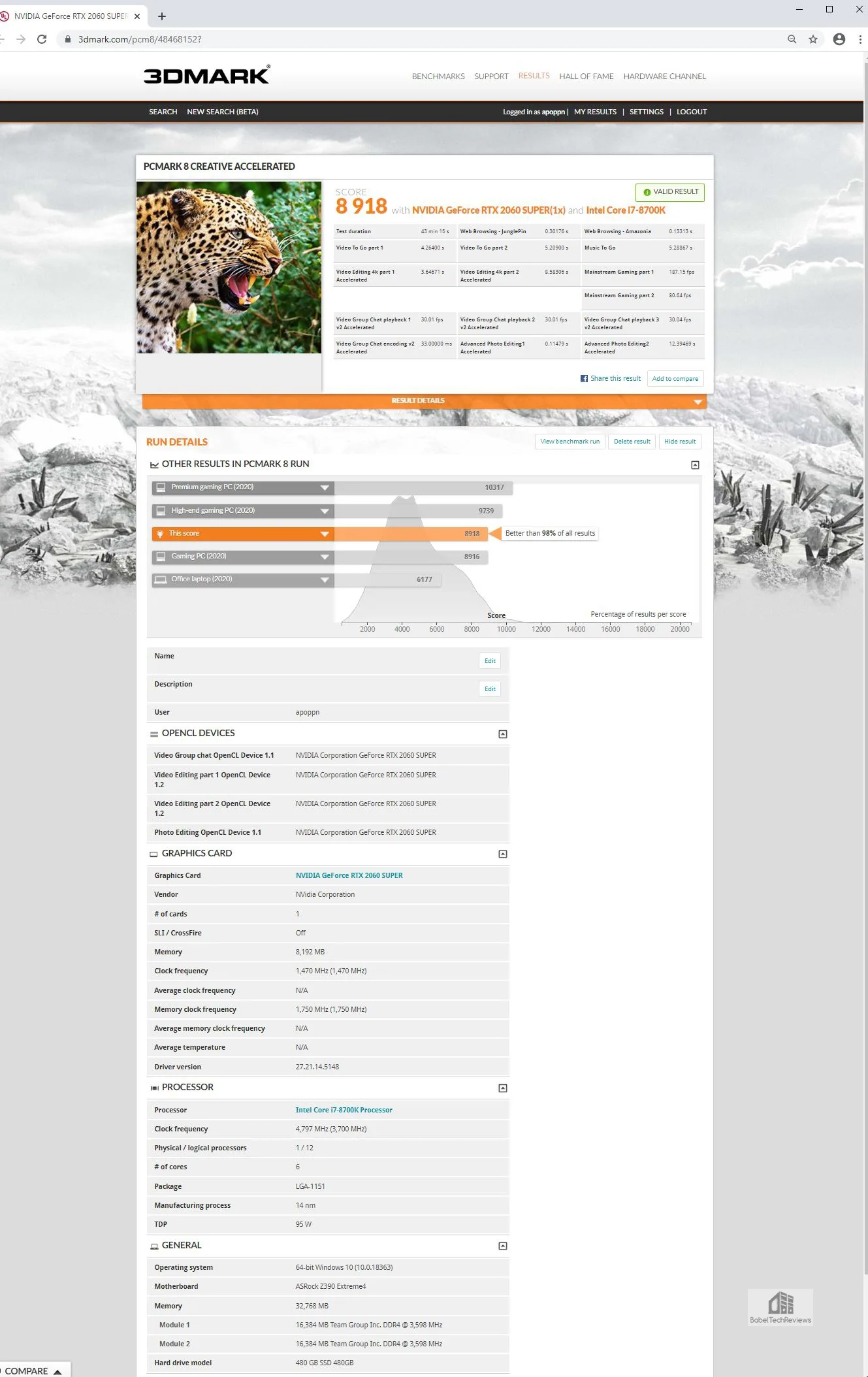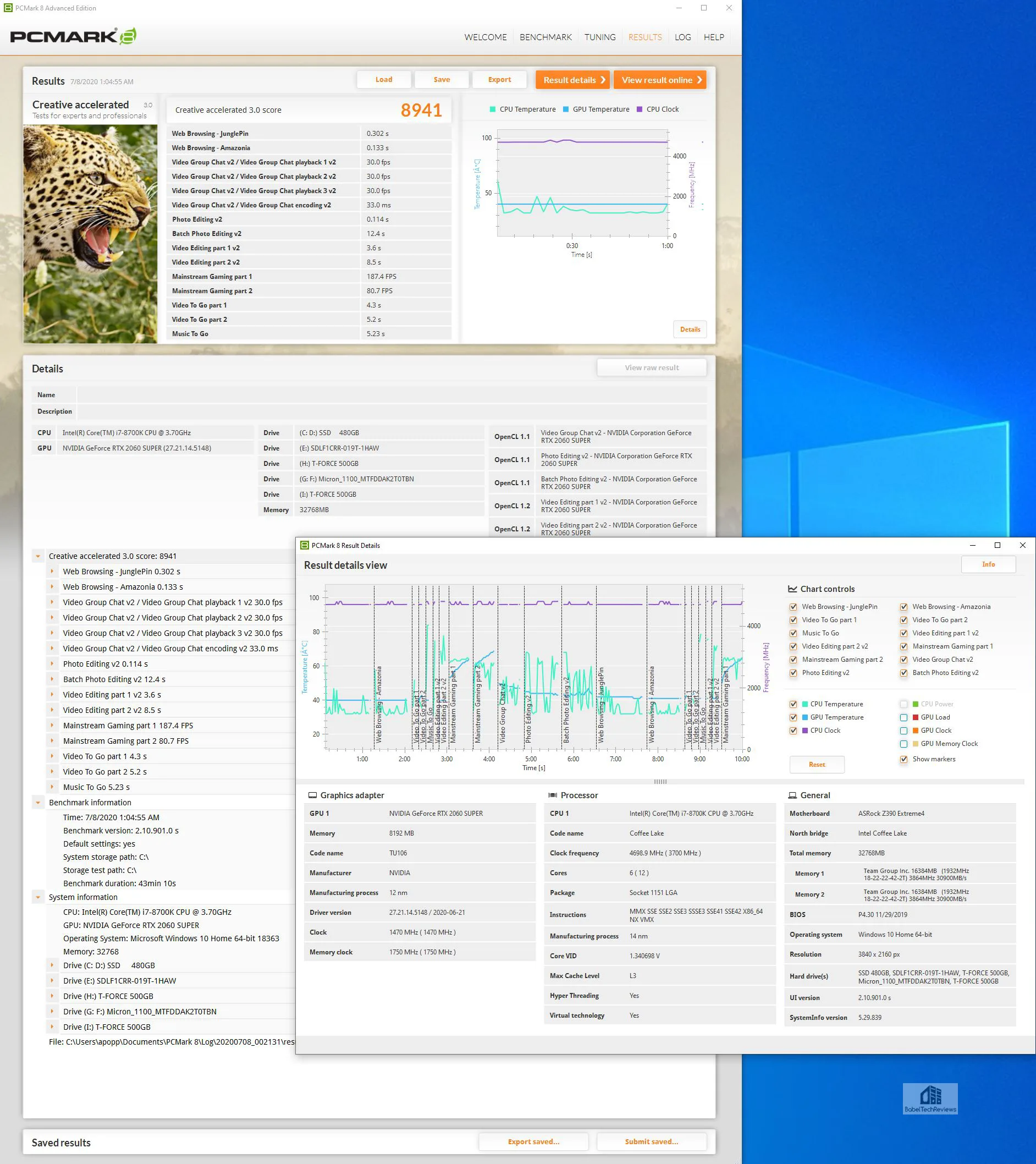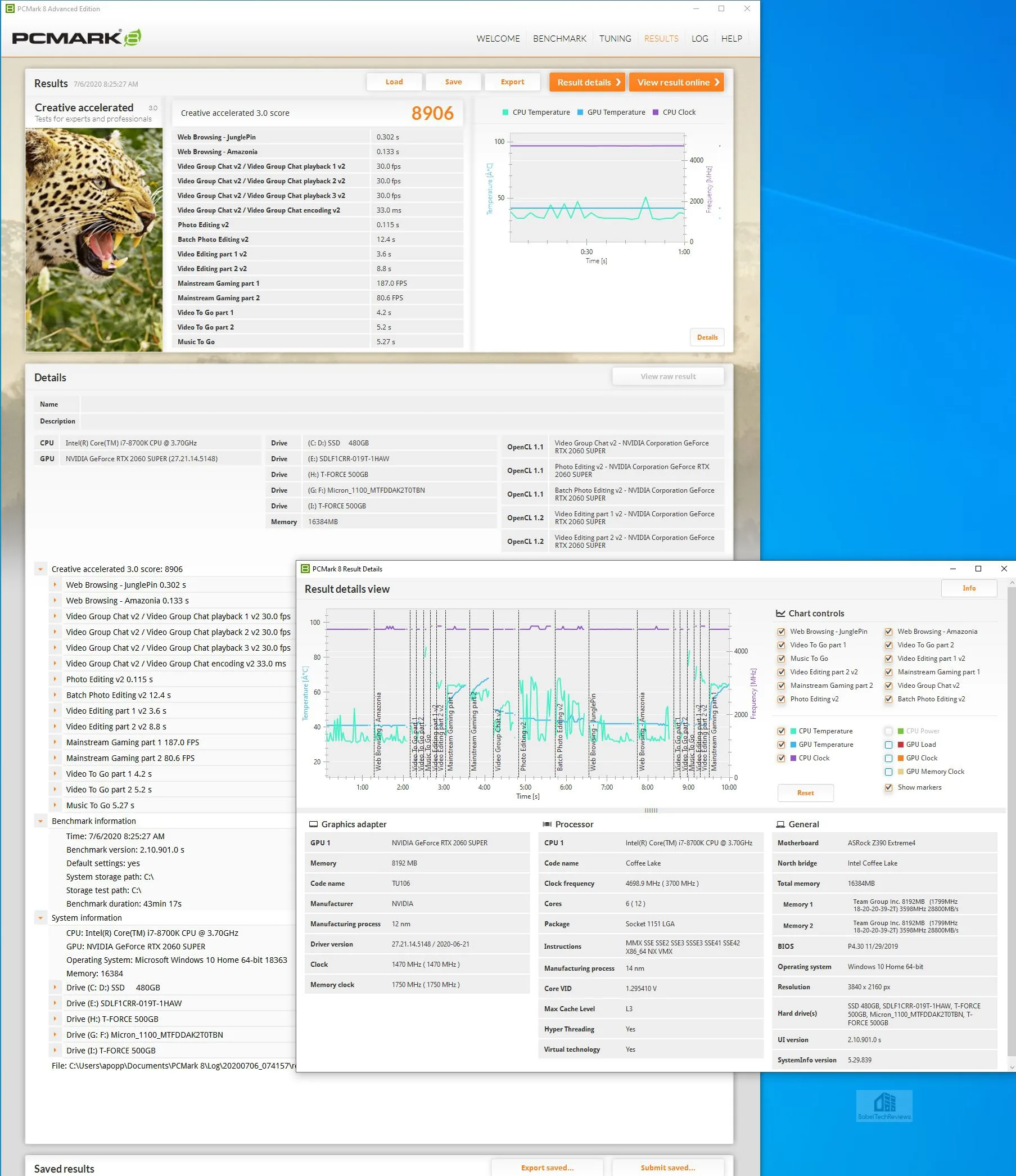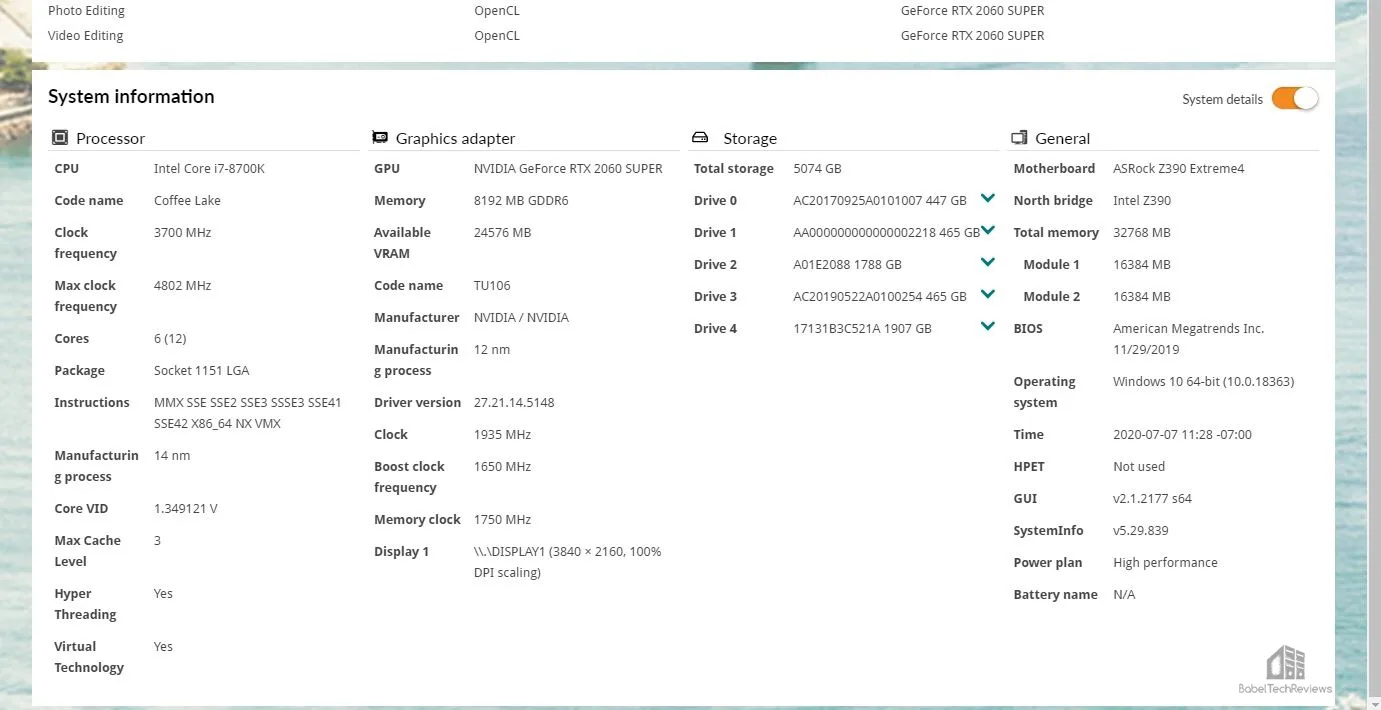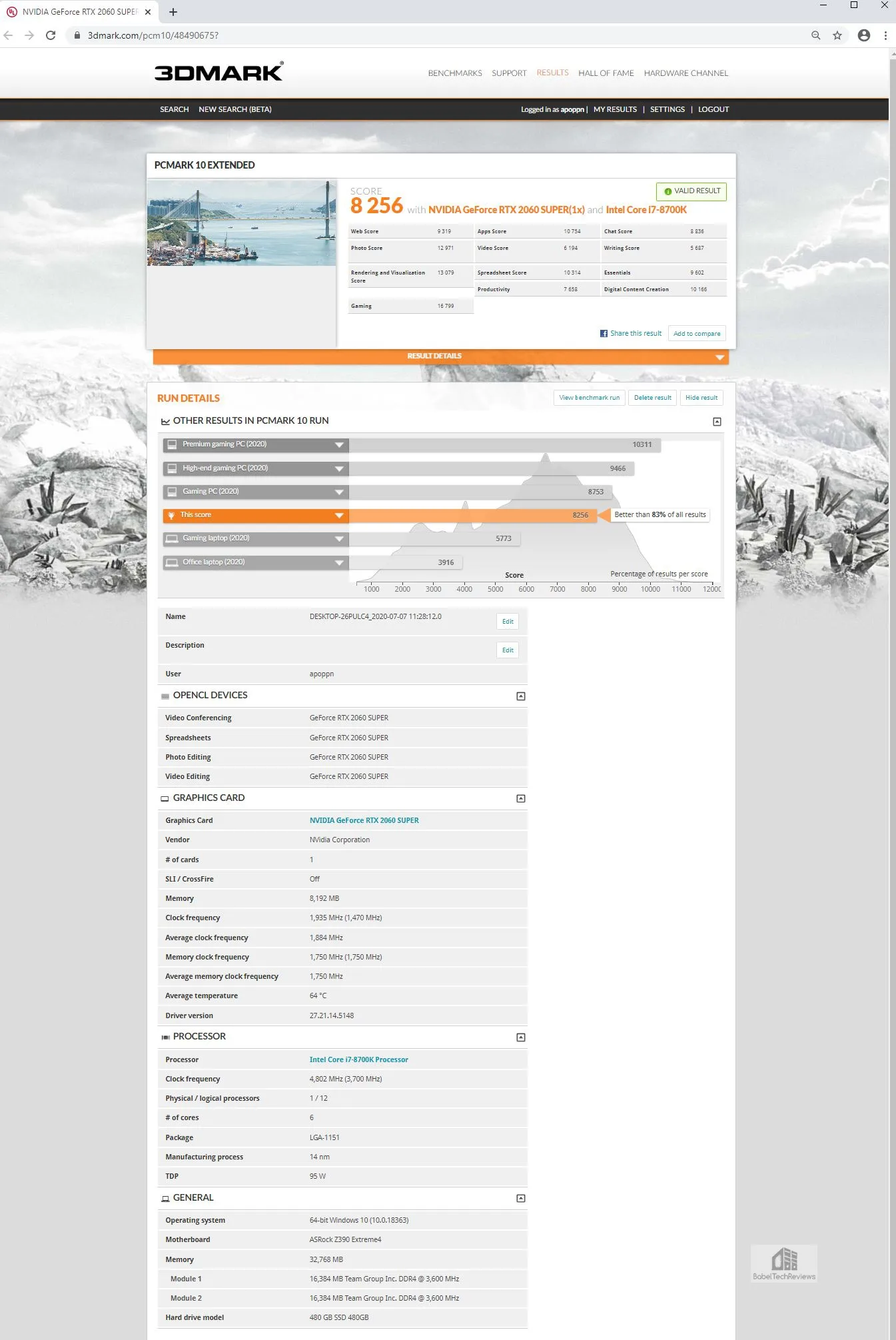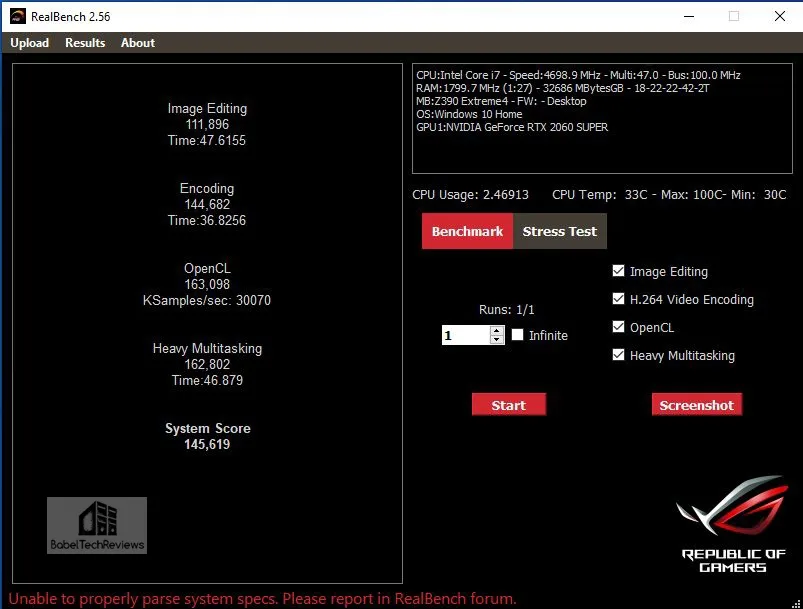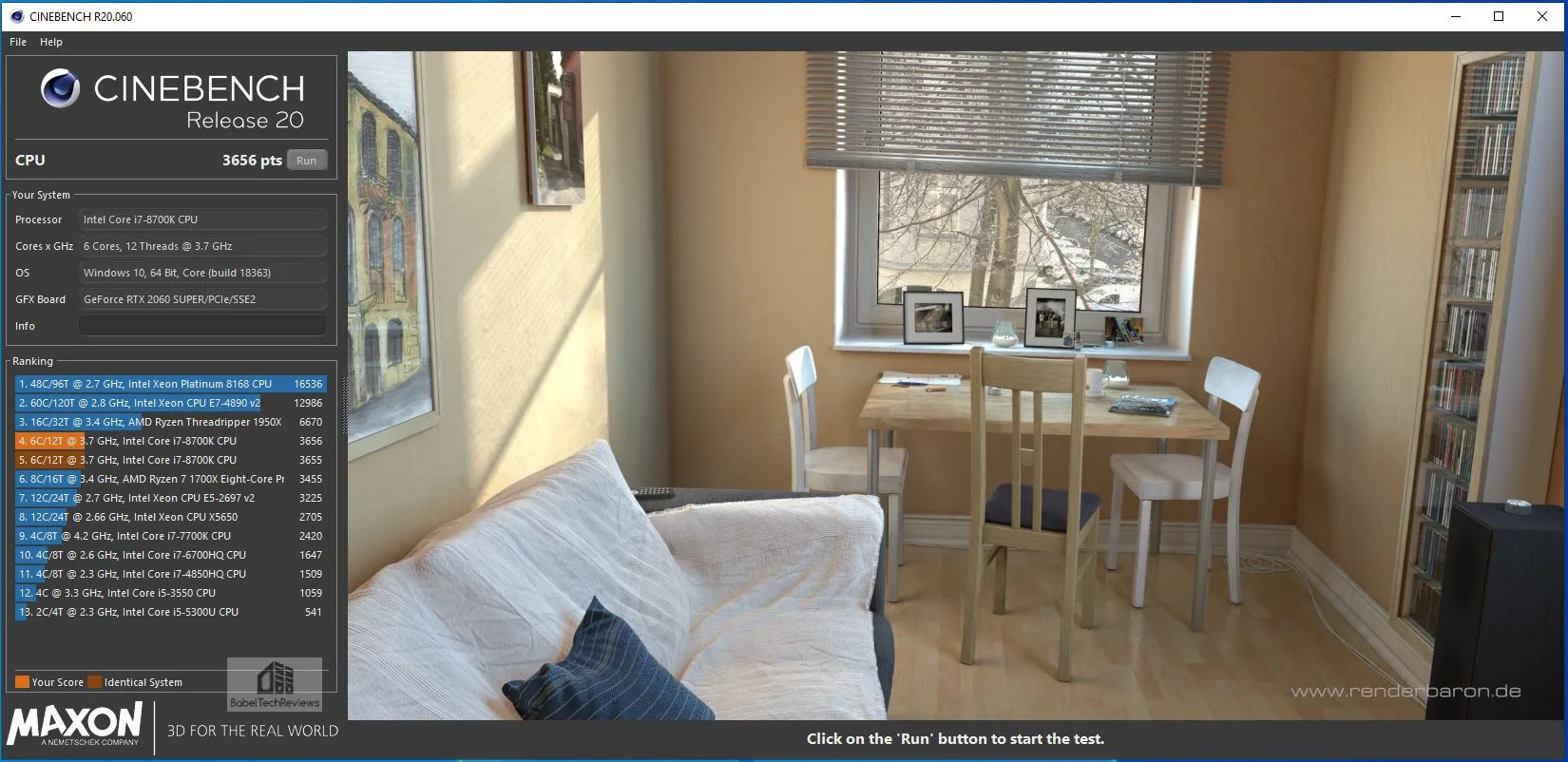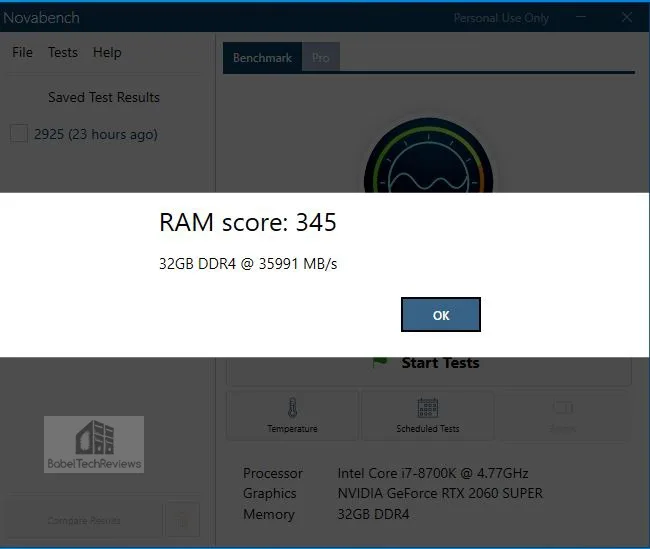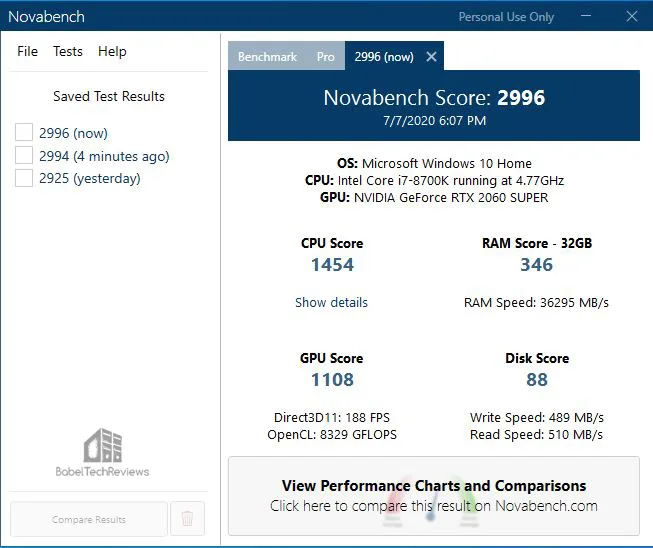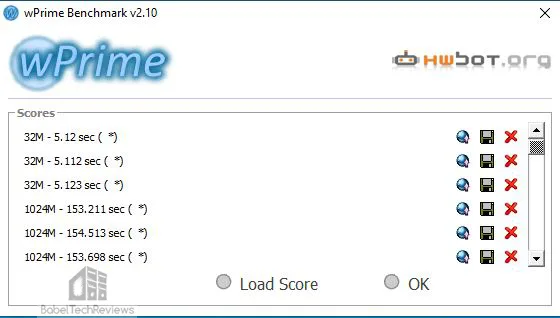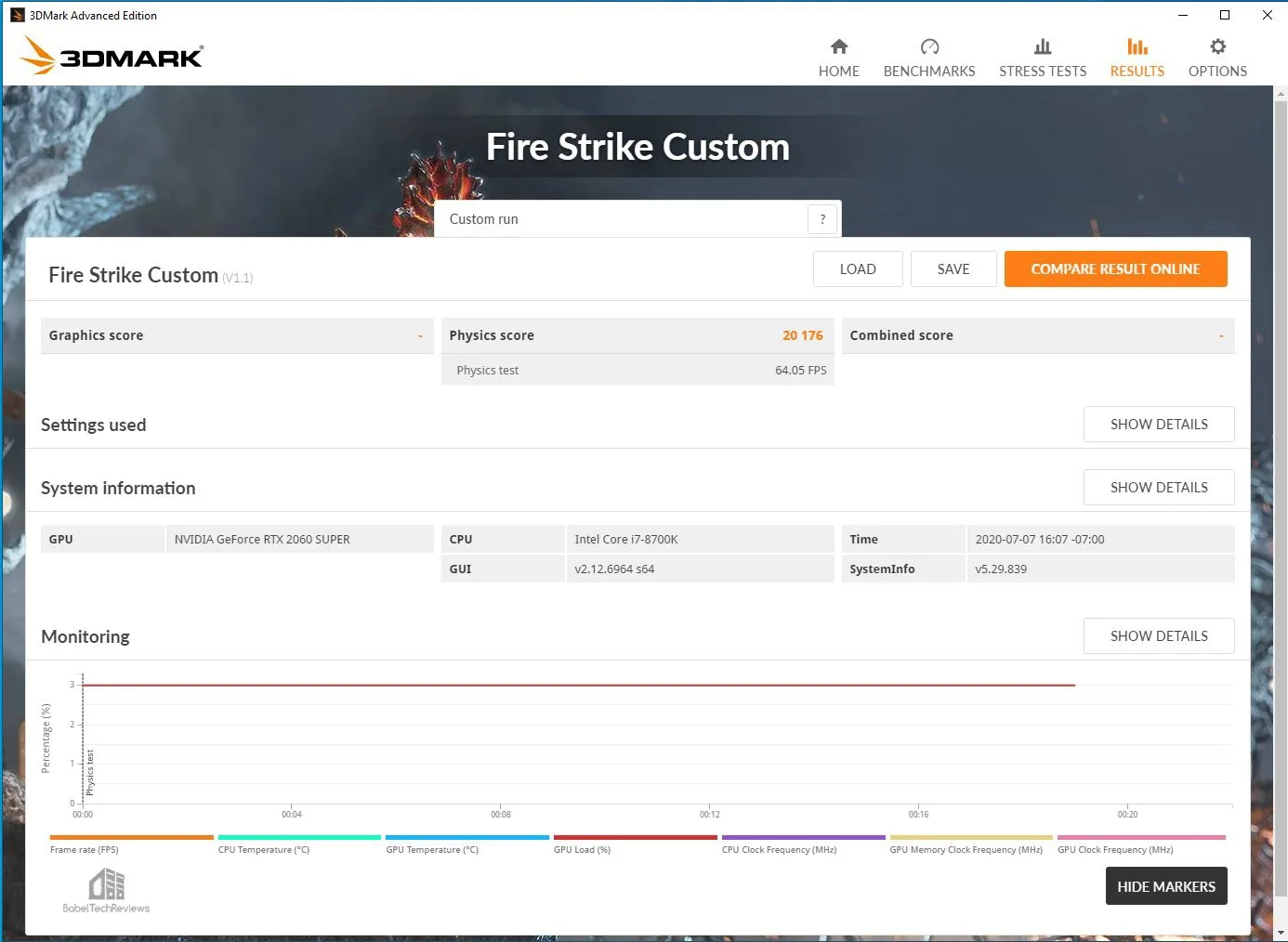T-FORCE DARK Z 3600MHz DDR4 2x16GB Kit Memory Review – is 32GB RAM Becoming the ‘New 16GB’ for Gaming ?
T-FORCE DARK Z DDR4 3600MHz desktop memory is a fast high-capacity 16GBx2 gaming memory kit that we are reviewing to see if 32GB brings anything extra for gamers over 16GB system memory. We also will overclock it to see if we can get additional performance.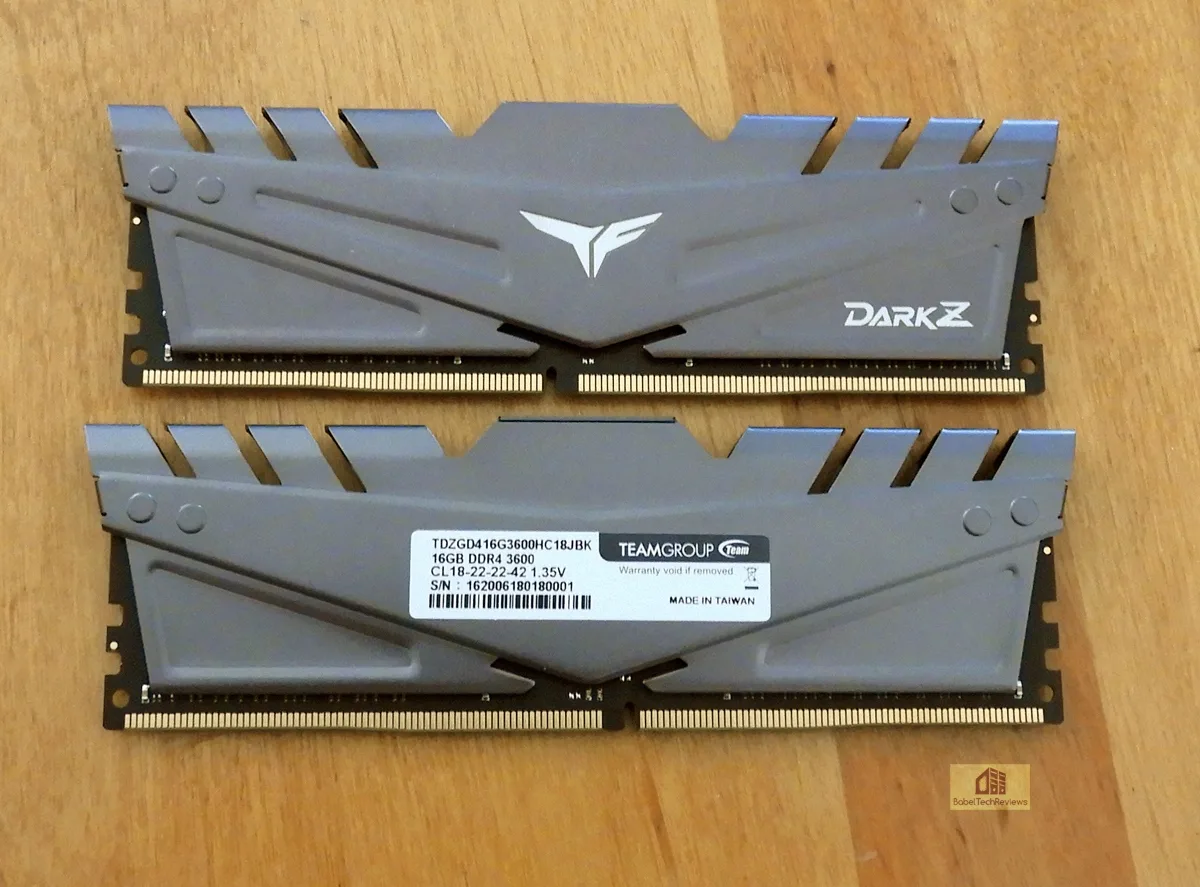
BTR currently uses 2x8GB of T-FORCE XTREEM DDR4 3600MHz CAS16 memory at 3866MHz for our benchmarking PC. For years, 16GB RAM has been considered the optimum capacity for higher-end PC gaming. Recently some gamers appear to promote 32GB as the new 16GB and necessary for “future proofing”. It is true that if a gamer multitasks while gaming – perhaps content streaming or creation, downloading/uploading, or with memory intensive programs working in the background – then perhaps 16GB may not be enough. And extreme gamers who are aiming for photorealism by modding games using ultra high textures may need more than 32GB of RAM.
From our testing with Ivy Bridge, Haswell, Skylake, and Coffee Lake platforms, using fast DDR over slower DDR brings only limited performance improvements for a few CPU-dependent games. However, we found that using faster memory results in extra overall performance gains for many other tasks and applications.
Here are the five memory kits that we are comparing:
- T-FORCE Vulcan DARK Z PC4 28800 DDR4 3600MHz CL18 (and overclocked) 2x16GB kit
- T-FORCE XTREEM PC4 28800 DDR4 3600MHz CL16 2x8GB kit
- HyperX Predator PC4 26600 3333MHz DDR4 CL16 2x8GB Kit
- T-FORCE Night Hawk PC4 25600 3200MHz DDR4 CL16 2x8GB kit
- T-FORCE T-1 Vulcan Z PC4 24000 DDR4 3000MHz CL16 2x32GB kit
The T-FORCE DARK Z DDR4 3600 2x16GB kit is $131.22 and $69.99 for the 16GB kit at Newegg. Team Group currently has special pricing from a promotion with Newegg that is ending in a few days together with a contest giveaway that anyone can enter. The ‘Fantastech’ sale is so good that we just bought a 1TB Team Group GX2 SATA III SSD for $80.99 shipped (!)
Click on the banner or here for the link. Scroll to the bottom for the contest giveaway rules.
Testing Platform
Our testing platform is a very recent clean installation of Windows 10 Home 64-bit, using an Intel Core i7-8700K at 4.80GHz in an ASRock Z390 Extreme 4 motherboard, a Team Group MP33 NVMe PCIe SSD, and with 32GB T-FORCE DARK Z DDR 3600MHz, 64GB of T-FORCE Vulcan Z DDR 3000MHz, 32GB of T-FORCE XTREEM 3600MHz, 16GB of Night Hawk 3200MHz, or HyperX DDR4 at 3333MHz. We used the RTX 2060 SUPER Founders Edition at stock clocks for our testing. The settings, benchmarks, testing conditions, and hardware are identical except for the three DDR4 kits being compared.
Except for the DARK Z at CAS18, the other four memory kits use CAS16, the voltages are set at a common 1.35V, and all Command Rates are set at 2T by their respective default XMP 1.0 profiles in the BIOS. The default XMP 1.0 Profile 1 of the T-FORCE DARK Z 3600MHz is CL18-22-22-42, while the T-FORCE Vulcan Z DDR4 3000MHz timings and the T-FORCE Nighthawk DDR4 3200MHz timings are both 16-18-18-38, but the HyperX 3333MHz default profile is 16-18-18-36. So we may expect that the DARK Z DDR4 3600MHz memory will offer slightly less performance than the XTREEM DDR4 3600MHz memory which has tighter timings.
We will compare the performance of all five DDR4 kits, and we will also overclock the DARK Z’s memory to chart the effects of multiple memory speeds on the performance of three modern games at a maxed-out/ultra 1920×1080 resolution. We benchmark using many of the recognized memory-related benchmarking tools including AIDA64, SANDRA, RealBench, PCMark 8 and 10, 3DMark, Cinebench, Novabench, Star Swarm demo, and Wprime.
This is BTR’s last review using our i7-8700K as we have just upgraded to Core i9-10900K.
Product Specifications & Features
Here are the memory specifications of the available DARK Z DDR4 SKUs from the Team Group website:
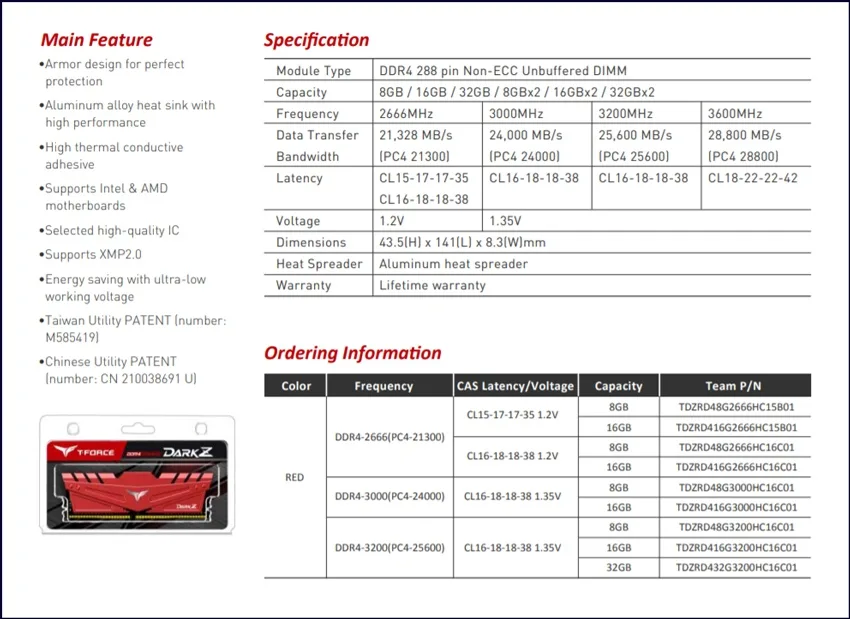
Using the XMP profile 1, voltage is automatically set at 1.35V for 3600MHz but may be manually adjusted in the BIOS from between 1.2V to 1.4V – or higher. XMP Profile 2 sets the memory speed at 3200MHz at 1.2V with tighter timings. Here are the DARK Z features also quoted directly from Team Group’s website:
Features
- Armor design for perfect protection
- Aluminum alloy heat sink with high performance
- High thermal conductive adhesive
- Supports Intel & AMD motherboards
- Selected high-quality IC
- Supports XMP2.0
- Energy saving with ultra-low working voltage
Team Group offers a lifetime warranty for their T-FORCE desktop memory and DARK Z is available in gray or red.
Let’s unbox the memory kit on the next page and take a closer look.
Unboxing
The T-FORCE DARK Z DDR4 3600MHz 2x16GB memory kit comes in a anti-static blister pack with a card that advertises its features on its reverse.
The T-FORCE logo uses a stylized hawk symbolizing a gamer’s independent spirit of flying free. The product card explains the history of T-FORCE and lists its product features.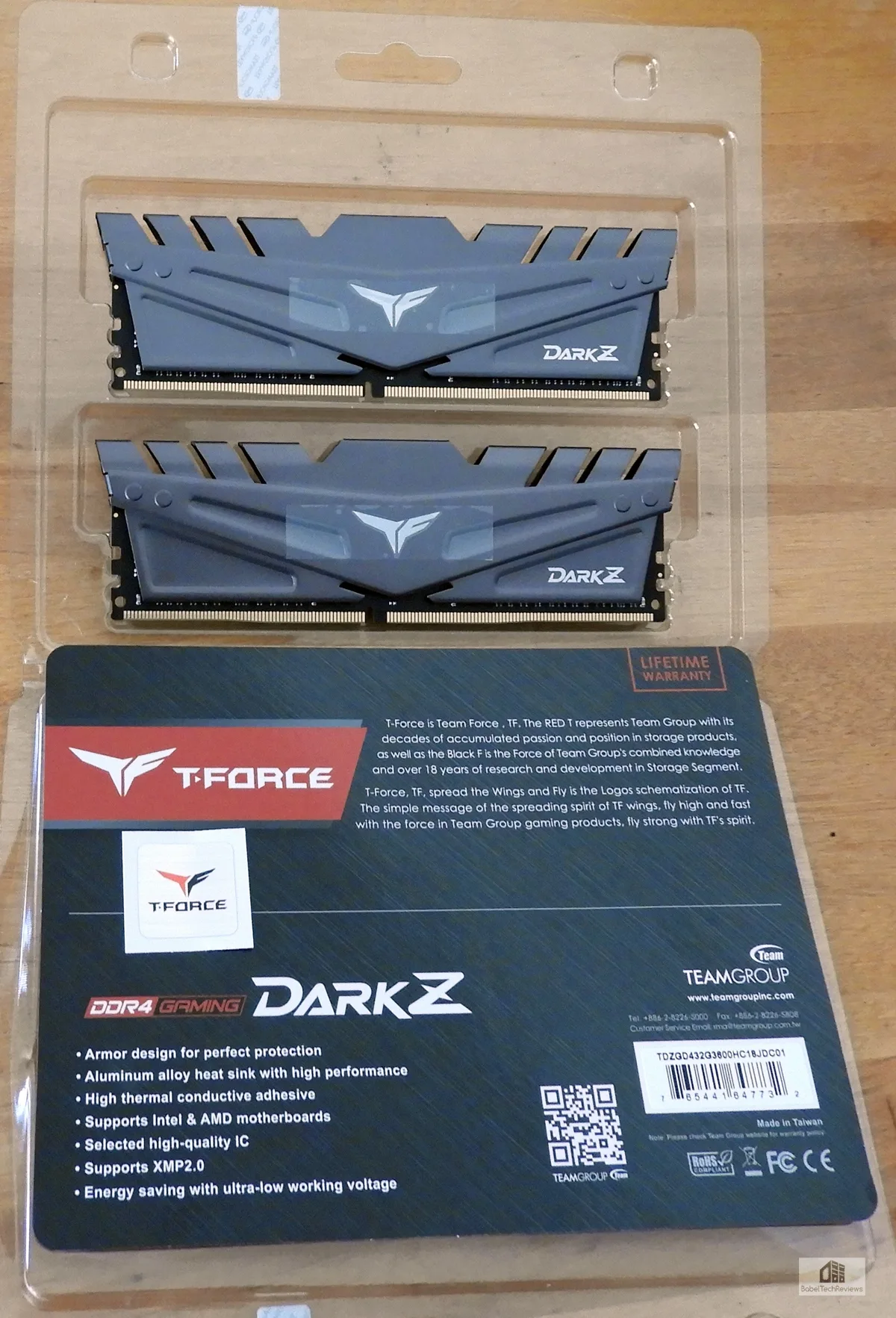
After we removed the memory out of the anti-static blister pack, we placed it next to the rest of the contents.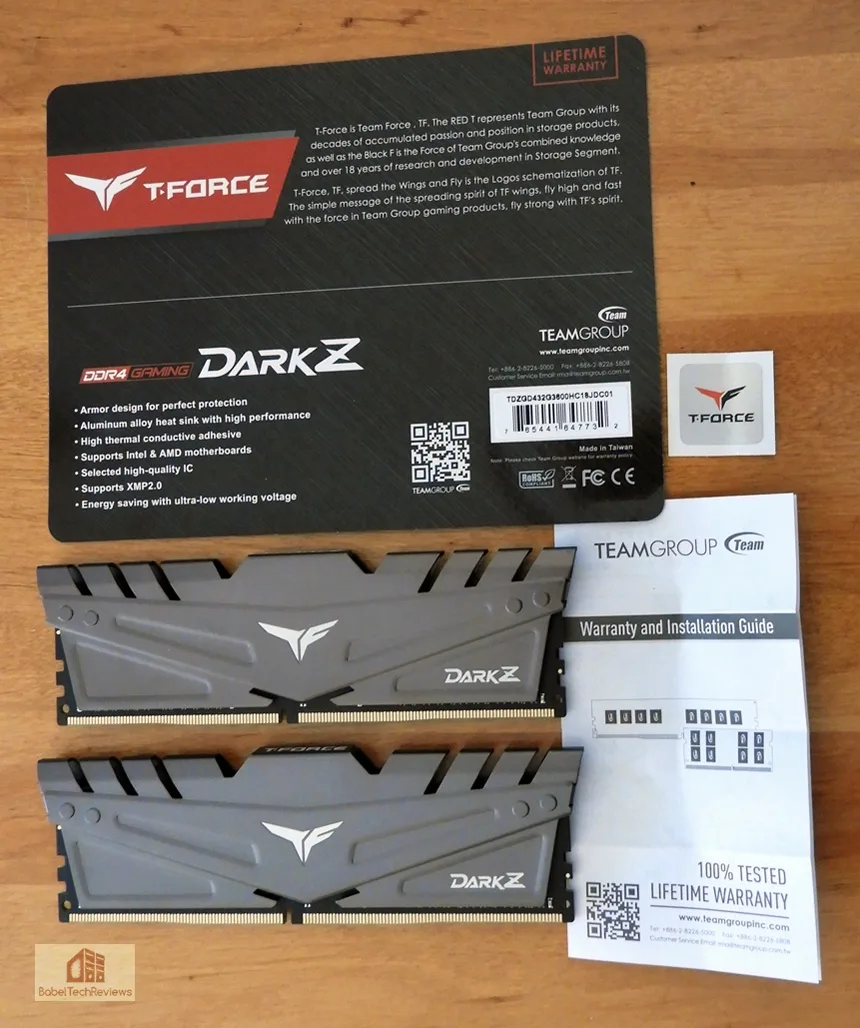
The installation guide is illustrated and it is easy to follow.
There is plenty of room in most cases and in motherboards for this memory unlike with the taller, bulkier, and heavier Night Hawk memory modules that may interfere with some large CPU air coolers. Dark Z looks great installed in a conservative build and it will be featured in BTR’s flagship upgraded i9-10900K PC.
First, let’s look at our test configuration.
Test Configuration – Hardware
- Intel Core i7-8700K (HyperThreading and Turbo boost are on to 4.8GHz for all cores; Coffee Lake DX11 CPU graphics).
- ASRock Z390 Extreme 4 motherboard (Intel Z390 chipset, latest BIOS, PCIe 3.0/3.1 specification, CrossFire/SLI 8x+8x)
- T-FORCE DARK Z PC4 28800 DDR4 3600MHz CL16 (and overclocked) 2x16GB kit
- T-FORCE XTREEM PC4 28800 DDR4 3600MHz CL16 2x8GB kit
- HyperX Predator PC4 26600 3333MHz DDR4 CL16 2x8GB Kit
- T-FORCE Night Hawk PC4 25600 3200MHz DDR4 CL16 2x8GB kit
- T-FORCE Vulcan Z PC4 24000 DDR4 3000MHz CL16 2x32GB kit
- RTX 2060 SUPER Founders Edition 8GB, at stock FE clocks, on loan from NVIDIA
- 1TB Team Group MP33 PCIe SSD
- 1.92 TB San Disk enterprise class SSD
- 2 TB Micron 1100 SSD
- 500GB T-FORCE Vulcan SSD, supplied by Team Group
- 500GB Delta Max RGB SSD, supplied by Team Group
- EVGA 1000G 1000W gold power supply unit
- Cooler Master 240mm CPU water cooler
- EVGA DG-77, mid-tower case supplied by EVGA
- Monoprice Crystal Pro 4K
Test Configuration – Software
- Nvidia’s GeForce 451.48 WHQL drivers. High Quality, prefer maximum performance, single display
- VSync is off in the control panel
- AA enabled as noted in games; all in-game settings are specified with 16xAF always applied
- Highest quality sound (stereo) used in all games
- Windows 10 64-bit Home edition
- Latest DirectX
- MSI’s Afterburner, latest version.
- CPU-Z
- MemTest64
- Windows Memory Diagnostics
- 3DMark Physics Test
- SiSoft Sandra 2020
- AIDA64
- PCMark 8 (Creativity Suite)
- PCMark 10 (Extended)
- Real Bench
- Cinebench R20
- WPrime
- Star Swarm Demo
- Blender 283
- Novabench
PC Game suite
- Anno 1800
- Grand Theft Auto V
- Civilization 6
Nvidia Control Panel settings:
We used MSI’s Afterburner to set the power and temp limits to their maximums.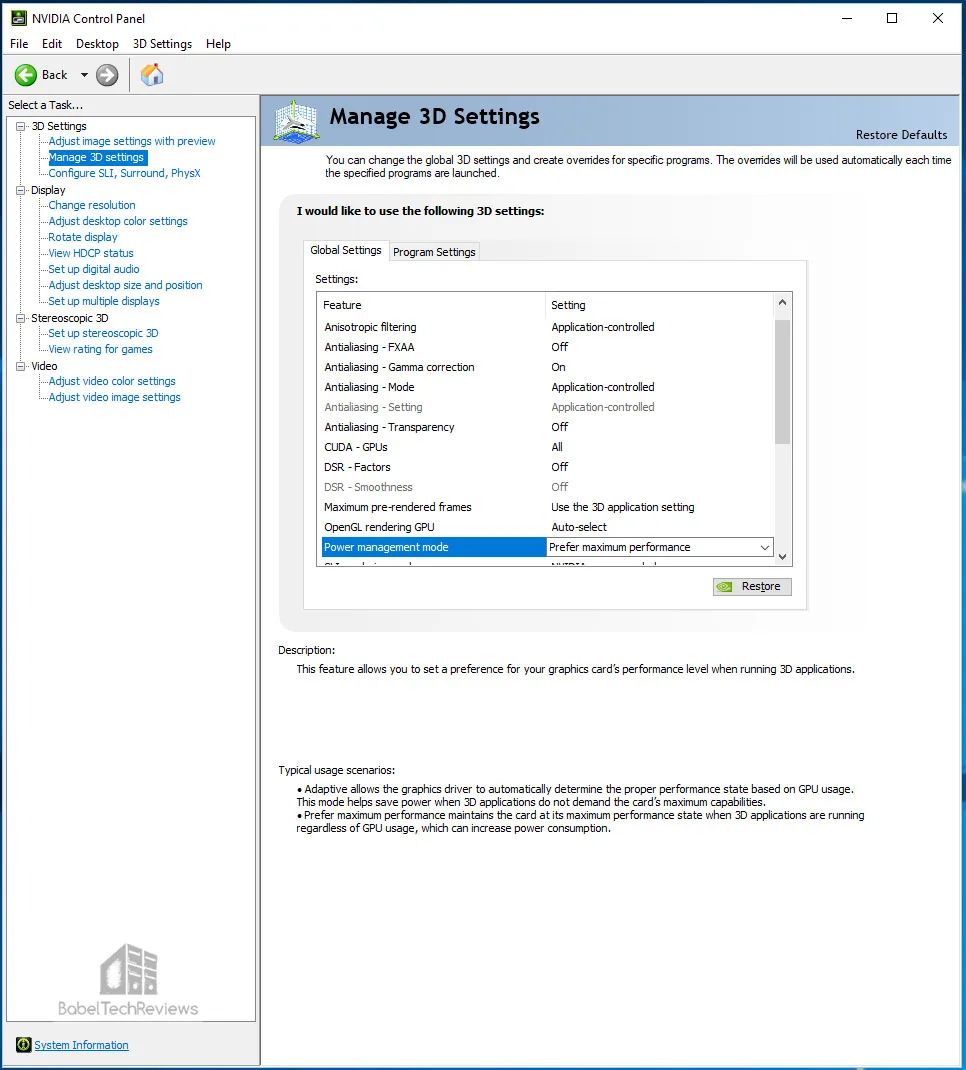
The Texture Filtering has been set to High and Vertical Sync has been disabled. Let’s head to our benching results.
Overclocking
Before we look at our benches, let’s explore overclocking the T-FORCE DARK Z above 3600MHz. We used the default timings of the DARK Z’s memory to increase its clocks until we reached its maximum stable speed at 1.4V. Tightening DDR’s timings tend to bring less performance gain than increasing clock speed and should probably be left until after the preliminary overclocking and stability tests have been completed.
Here is CPU-Z showing the DARK Z’s stock XMP Profile 1 timings and speeds:
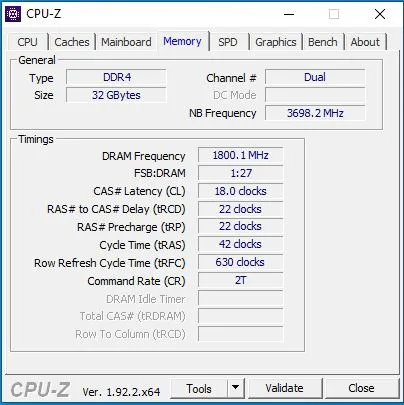
CAS Latency is 18.0 so it has more relaxed timings than our other four memory kits which are 16.0. Here is DARK Z overclocked to 3866MHz with its same timings as at 3600MHz but now at 1.4V for stability:
We used our own self-imposed hard cap of 1.4V which we used to stabilize the memory overclock. After much experimentation, we finally settled on an overclock of 3866MHz or +266MHz offset which are several speed grades above 3600MHz. It refused to post above 3900MHz, and it would probably have required more the 1.4V that we are willing to use.
We tested our overclock using AIDA64’s System Test. It stresses the memory and also the CPU. We also confirmed that our overclock to 3866MHz was stable by running MemTest/64 and Windows Memory Diagnostics overnight, as well as by playing games and running BTR’s other benching suites.
We believe that overclocking +286MHz from 3600MHz to 3866MHz may be a good middle ground for many enthusiasts wanting great value, long memory life, stability and increased performance. A more hardcore overclocker may want to aim for the highest overclock that their memory can reach, and then fine-tune the timings and voltage for maximum memory performance.
It is important to look at synthetic benchmarks to highlight the differences between our five memory samples and also note improving application and game performance as we increase the DARK Z memory’s clock speeds from 3600MHz to 3866MHz.
Benchmarking
Individual chart results are always listed in order: 1) DARK Z 3600MHZ, 2) OC DARK Z 3866MHz, 3) XTREEM 3600MHz, 4) HyperX Predator 3333MHz, 5) NightHawk 3200MHz, and 6) Vulcan Z 3000MHz. However, on the charts, the overclocked DARK Z 3866MHz is listed first before the stock DARK Z 3600MHz although the order remains the same for the other memory kits.
Synthetic Benches
SiSoft Sandra 2020
To see where memory performance results differ, and there is no better tool than SiSoft’s SANDRA 2020. SiSoftware Sandra (the System ANalyser, Diagnostic and Reporting Assistant) is an complete information & diagnostic utility in a complete package. It is able to provide all the information about your hardware, software and other devices for diagnosis and for benchmarking. Sandra is derived from a Greek name that implies “defender” or “helper”.
There are several versions of Sandra, including a free version of Sandra Lite that anyone can download and use. It is highly recommended! SiSoft’s Sandra 2020 R7 is the very latest version, and we are using the full engineer suite courtesy of SiSoft. The latest version features multiple improvements over earlier versions of Sandra. It will benchmark and analyze all of the important PC subsystems and even rank your PC and give recommendations for improvement.
We run the SANDRA memory intensive benchmark tests. Here is the chart summarizing the results of our memory speed testing. 
The DARK Z’s memory performance compares favorably with the other 3600MHz kit and it scales upward with overclocking.
We next feature AIDA64.
AIDA64 v6.00
AIDA64 as the successor to Everest is an important industry tool for benchmarkers. Its memory bandwidth benchmarks (Memory Read, Memory Write, and Memory Copy) measure the maximum available memory data transfer bandwidth. AIDA64’s benchmark code methods are written in Assembly language, and they are extremely optimized for every popular AMD, Intel and VIA processor core variants by utilizing the appropriate instruction set extensions. We use the Engineer’s full version of AIDA64 courtesy of FinalWire. AIDA64 is free to to try and use for 30 days.
The AIDA64 Memory Latency benchmark measures the typical delay from when the CPU reads data from system memory. Memory latency time means the time is accurately measured from the issuing of the read command until the data arrives to the integer registers of the CPU. It also tests Memory Read, Write, and Copy speeds besides Cache.
The T-FORCE DARK Z 3600MHz DDR4 is first.
Next we overclock the DARK Z 3600MHz memory to 3866MHz and note an overall performance increase.
The T-FORCE XTREEM 3600MHz DDR4 is next.
The T-FORCE Vulcan Z 3000MHz DDR4 results are next
Here is the T-FORCE Night Hawk 3200MHz DDR4 results.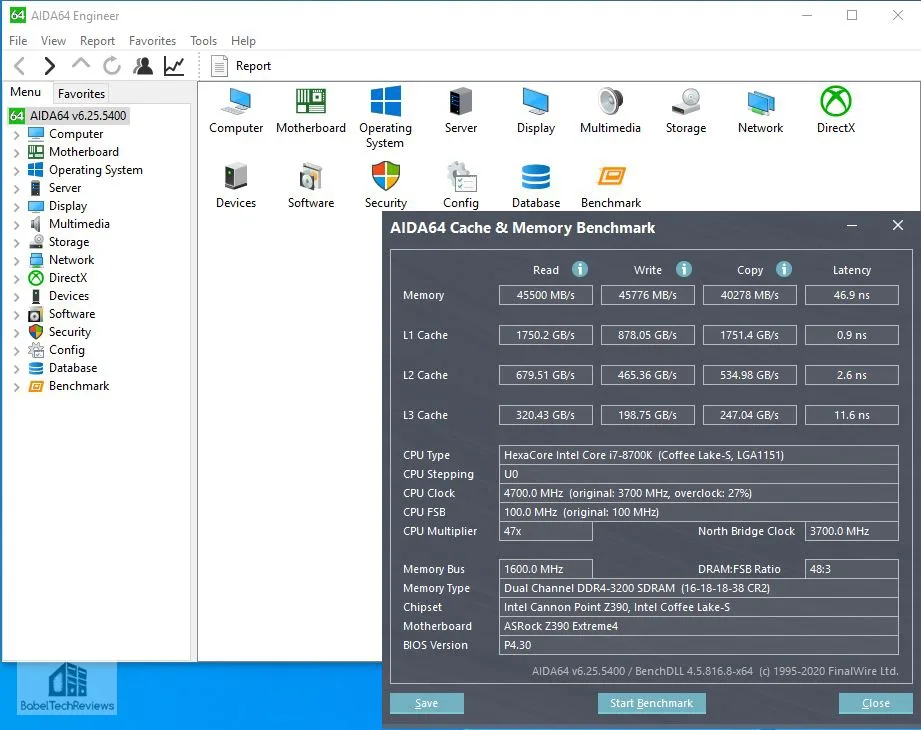
Here are the HyperX Predator 3333MHz DDR4 results.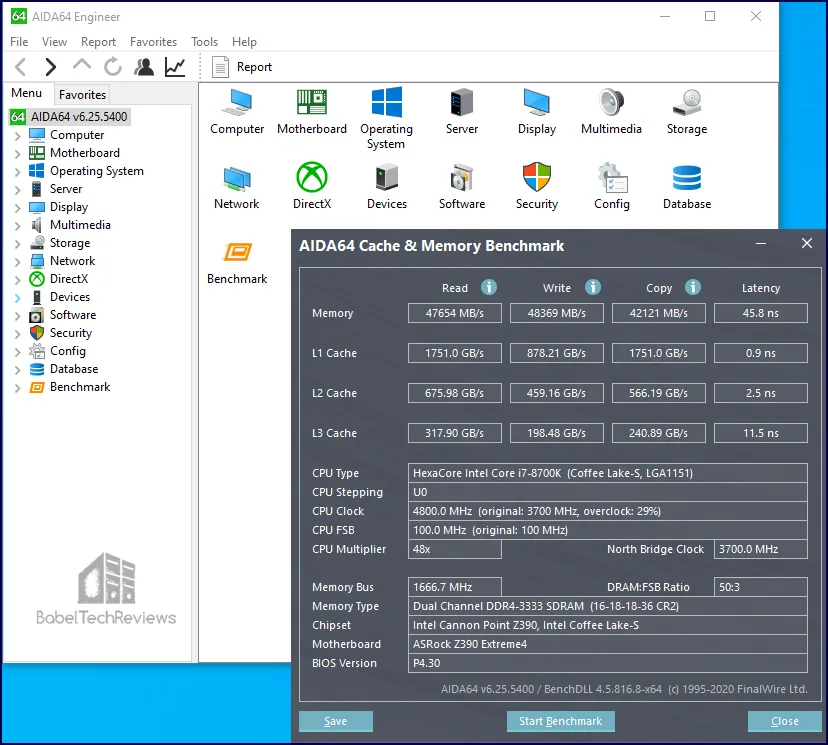
Here is the summary chart of the multiple AIDA64 memory benchmarks.
Faster memory scores higher and T-FORCE Vulcan Z memory scores continues to scale with overclocking. DARK Z Memory Write performance is lower than the other memory.
Let’s look at PCMark 8 next to see if its benchmarks can reflect memory speed increases.
PCMark 8
PCMark 8 has an Creative test which uses real world timed benchmarks including web browsing, video group chat, photo, batch, and video editing, music and video tests, and even mainstream gaming. Since the PCMark 8 Storage Test does not test the CPU, there is no performance difference from increasing memory clock speeds so we used the Creative benchmark suite.
The T-FORCE DARK Z 3600MHz DDR4 scores 8918.
Here is the online validation
Next we overclock the DARK Z 3600MHz memory to 3866MHz and note a performance increase from 8918 to 8941.
The T-FORCE XTREEM 3600MHz DDR4 scores 8906.
Here are the HyperX Predator 3333MHz DDR4 results. It scores 8862.
Here is the T-FORCE Night Hawk 3200MHz DDR4. It scores 8866.
Finally, the T-FORCE Vulcan Z 3000MHz DDR4 scores 8938.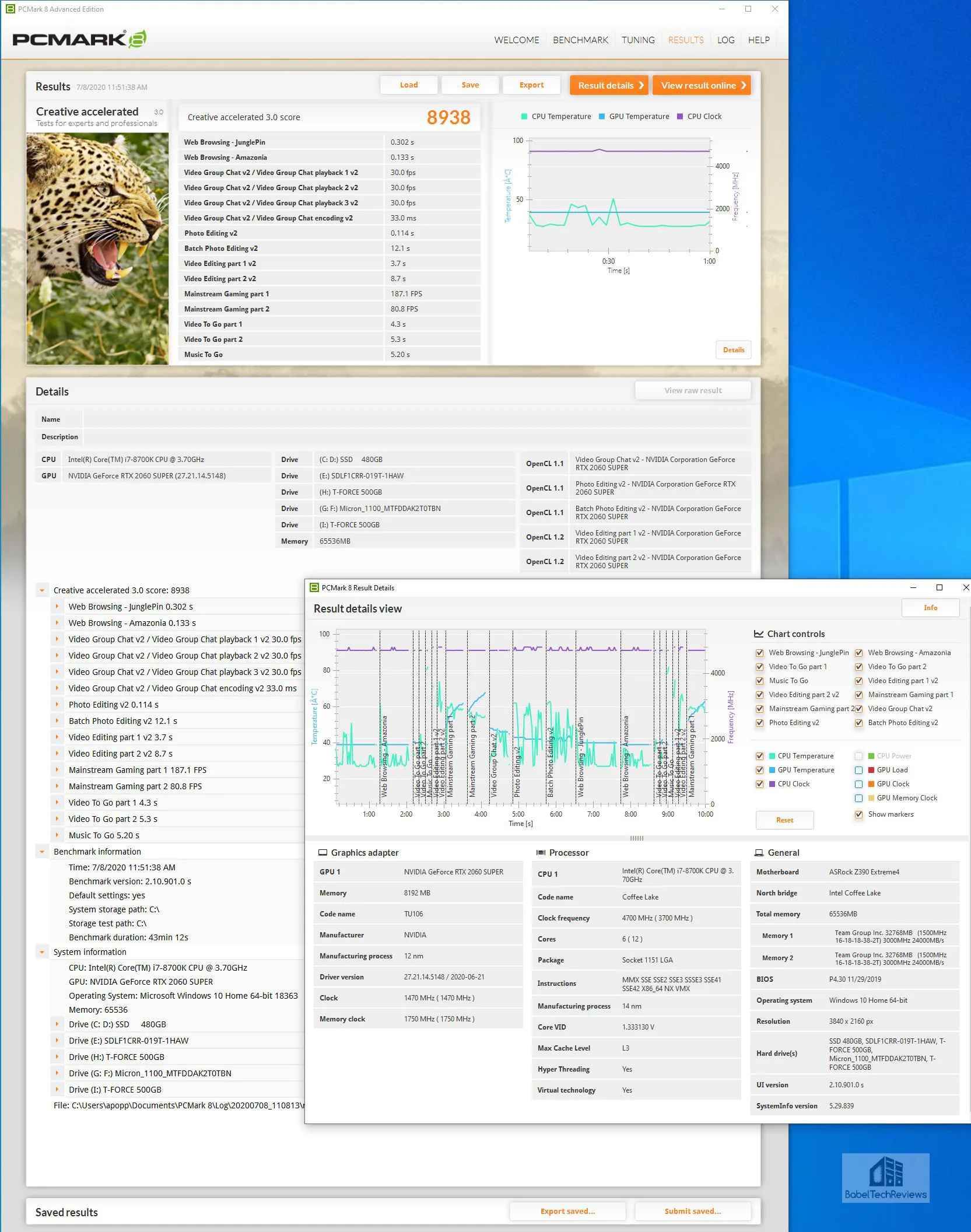
We may perhaps infer from the summary chart that increasing RAM speed may help increase overall performance as reflected by the PCMark 8 scores.
PCMark 10 is next.
PCMark 10
PCMark 10 benching suite is the follow-up to PCMark 8 and it also uses real world timed benchmarks which include web browsing, video group chat, photo, batch, and video editing, music and video tests, and even mainstream gaming. The PCMark 10 test offers two primary tests and we chose the extended version. In all cases, we show the test results from the desktop.
The T-FORCE DARK Z 3600MHz DDR4 is first with a score of 8256.
Here is the online validation.
Next we overclock the DARK Z 3600MHz memory to 3866MHz and note an overall performance increase from 8256 to 8272.
The T-FORCE XTREEM 3600MHz DDR4 scores 8282.
Here are the HyperX Predator 3333MHz DDR4 results with 8251.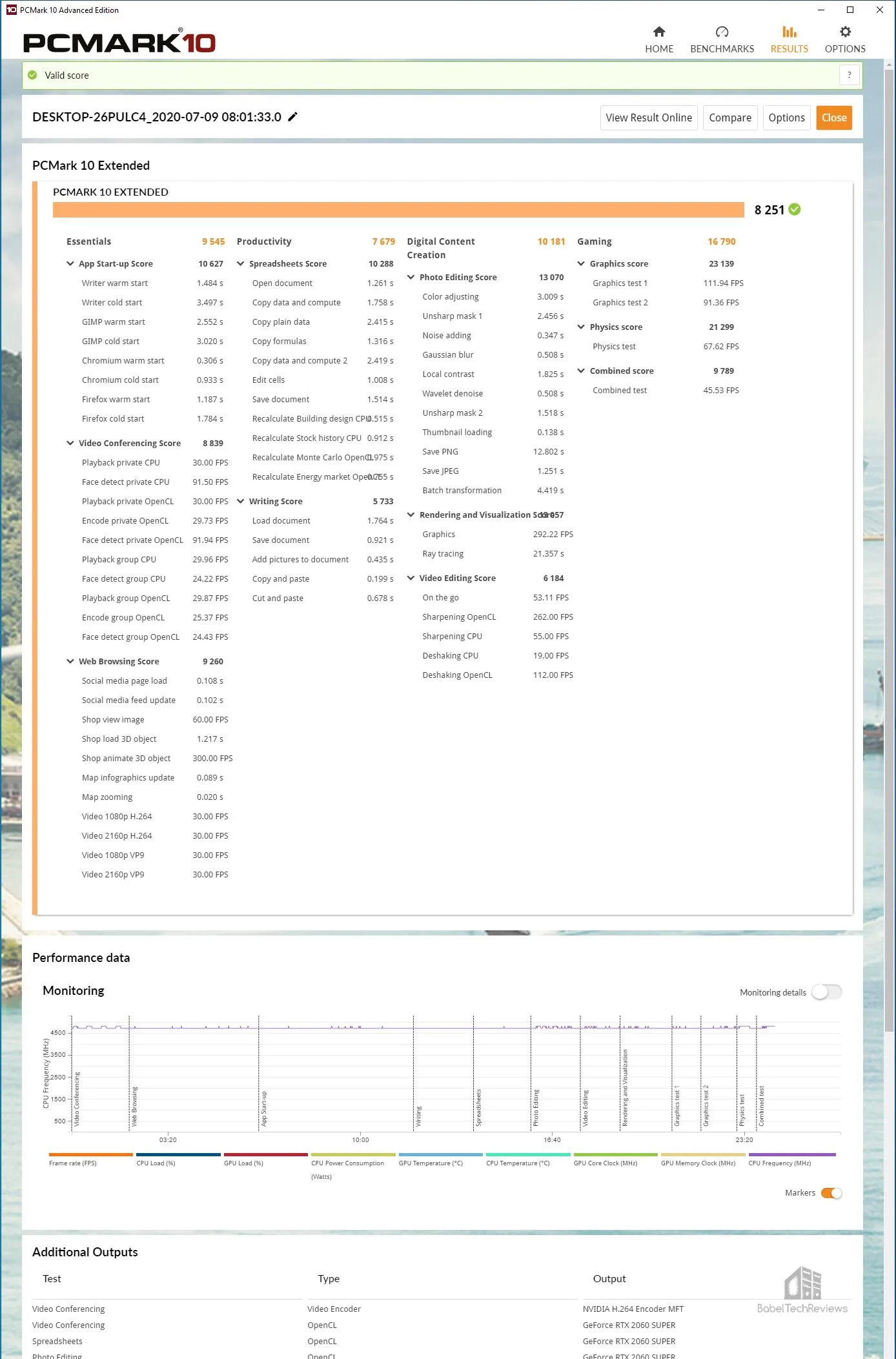
The T-FORCE NightHawk 3200MHz DDR4 scores 8255.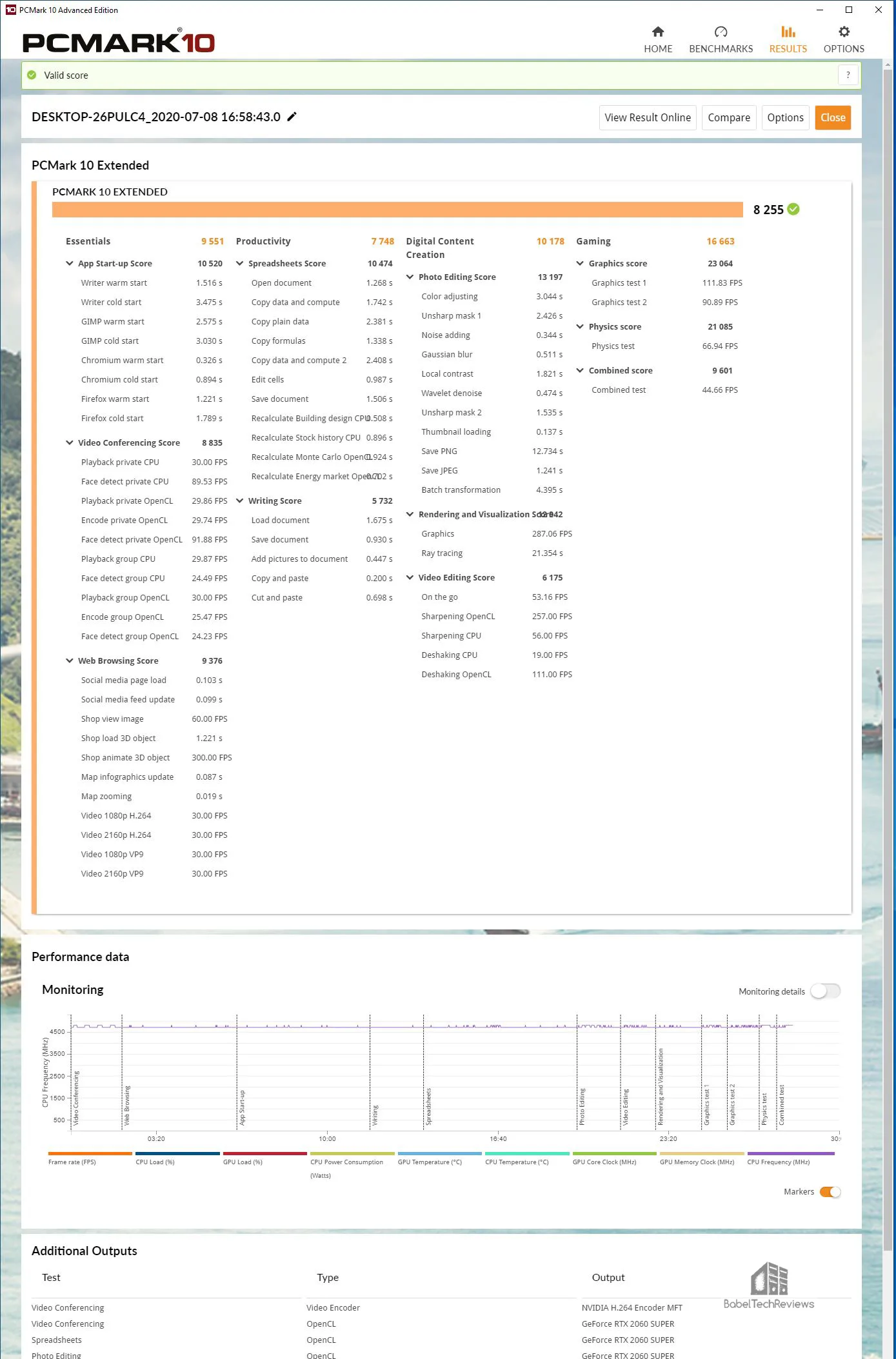
Finally, the T-FORCE Vulcan Z 3000MHz DDR4 scores 8191.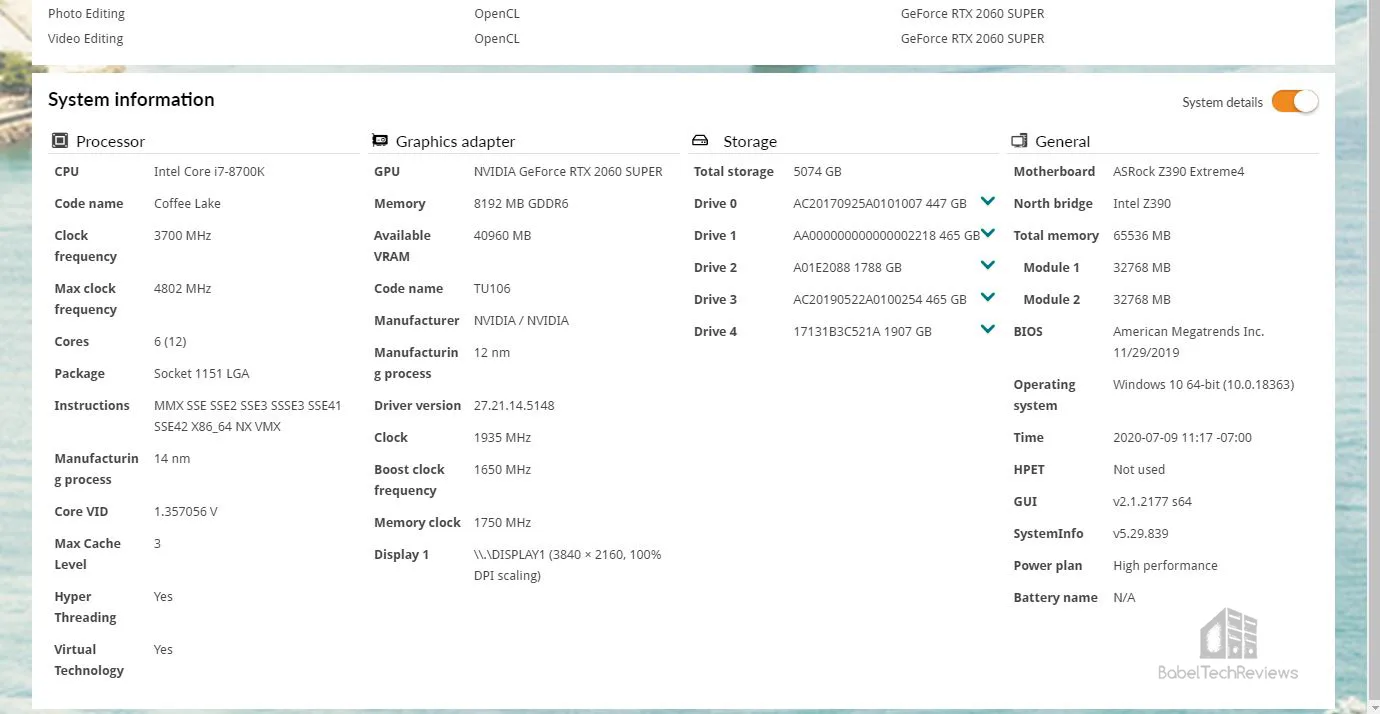
Here is the PCMark 10 summary chart:
The PCMark 10 overall results show an increase in scores as the memory speeds get faster although the HyperX memory at 3333MHz barely matches the Nighthawk 3200MHz score. Overclocking DARK Z DDR4 from 3600MHz to 3866MHz brings a performance increase although the XTREEM DDR4 3600MHz still scores better and it’s possibly due to having tighter timings.
Let’s look at our next synthetic test, RealBench.
RealBench v2.56
RealBench is a benchmarking utility by ASUS Republic of Gamers which benchmarks image editing, encoding, OpenCL, Heavy Multitasking, and gives out an overall score for easy comparison off or online. Some of these tests are affected by CPU and memory speeds.
The T-FORCE DARK Z 3600MHz DDR4 scores 145,609.
Next we overclock the DARK Z 3600MHz memory to 3866MHz and note an overall performance increase to 146,268.
Here are the individual tests summarized.
Just like with PCMark, the individual results are inconclusive but the scores generally increase with higher memory clocks.
Next we benchmark using Cinebench.
Cinebench
CINEBENCH is based on MAXON’s professional 3D content creation suite, CINEMA 4D. This latest R20.0 version of CINEBENCH can test up to 64 processor threads accurately and automatically. It is an excellent tool to compare both CPU/memory and graphics OGL performance. We are going to focus only on the CPU which is given is cb, and higher is always better.
The T-FORCE DARK Z 3600MHz DDR4 is first with 3656 pts.
Next we overclock the DARK Z 3600MHz memory to 3866MHz and note an overall performance increase from 3656 to 3665.
There is very little difference between the scores as shown by the chart summarizing the Cinebench runs.
Small performance increases with memory speed scaling are implied by the overall scores. Next up, Novabench.
Novabench
Novabench is a very fast benching utility that spits out a memory score showing the overall bandwidth speeds.
The T-FORCE DARK Z 3600MHz DDR4 is first with 35991MB/s.
Next we overclock the DARK Z 3600MHz memory to 3866MHz and note an overall performance increase from 35,991 MB/s to 36,295MB/s.
Here are the Novabench memory scores summarized in a chart.
The Novabench results seem to fall in-line with the other synthetic benchmarking suites by showing performance increasing with faster RAM speeds and/or overclocking.
On to Wprime and number crunching.
WPrime v2.10
WPrime is a multi-threaded benchmark which can show the differences in IPC between CPUs, and faster memory may also make a difference. Here are the tests using 6 threads, and we choose to calculate 1024 million digits and 32 million digits showing multiple runs.
The T-FORCE DARK Z 3600MHz DDR4 is first.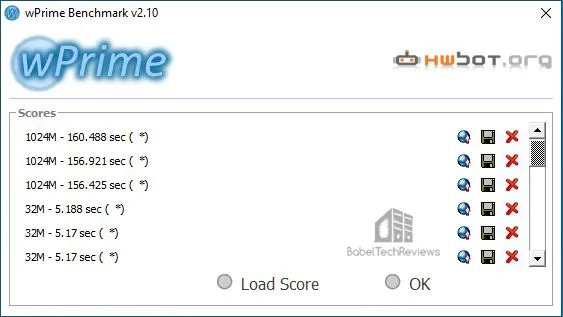
Next we overclock the DARK Z 3600MHz memory to 3866MHz and note an overall performance increase as the calculations get quicker and over 3 seconds are shaved from the 1024M results.
Here is the Wprime comparison chart with the fastest numbers from each set of runs compared.
If you increase the memory speed, the CPU may crunch numbers a little faster but there isn’t enough consistency with Wprime results to show it is completely dependent on memory clock speeds.
Let’s look at quasi game-related benchmarks starting with Star Swarm Demo next.
Star Swarm Demo
Star Swarm demo is the original genesis for Ashes of the Singularity – and unlike the finished game – it is very demanding on the CPU and will usually demonstrate increased framerates by using faster CPU and/or memory clocks.
The T-FORCE DARK Z 3600MHz DDR4 is first.
Next we overclock the DARK Z 3600MHz memory to 3866MHz and note a small 2.5 FPS performance increase.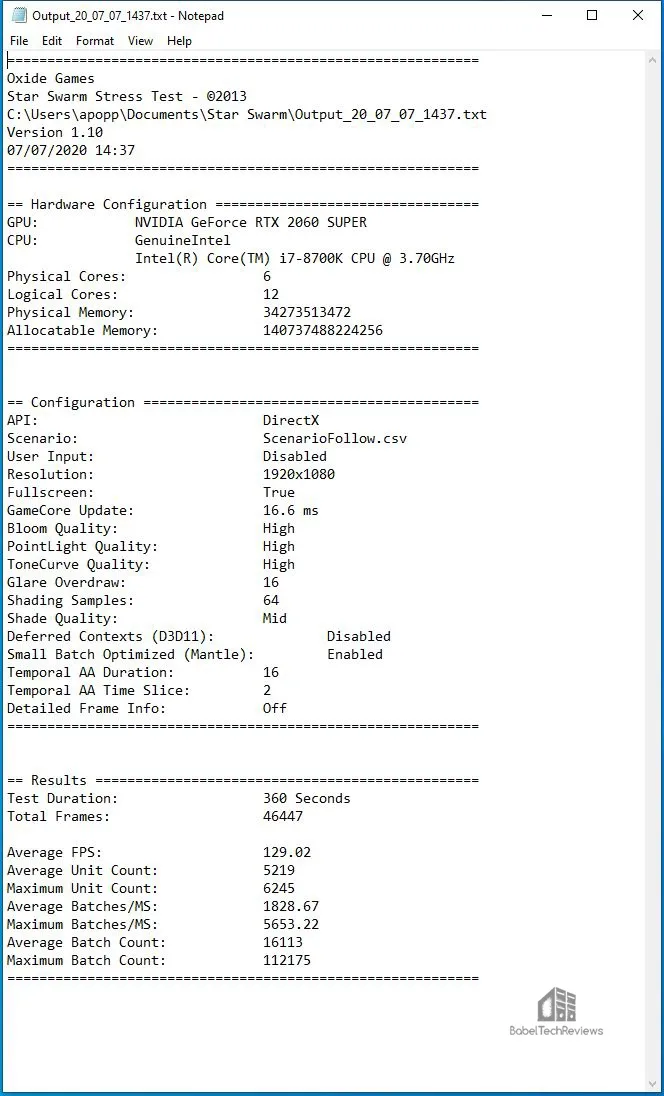
Here is the summary chart:
The Star Swarm demo does not produce identical benchmark runs so there is some extra variability built in and the Nighthawk memory scores very low compared to the other memory configurations.
Next we check out the Fire Strike Physics test.
Fire Strike Physics
Fire Strike Physics depends less on the GPU and more on the CPU which can benefit from increased memory speeds.
The T-FORCE DARK Z 3600MHz DDR4 is first.
Next we overclock the DARK Z’s 3600MHz memory to 3866MHz and note a very tiny performance increase.
Here is the summary chart. There isn’t a lot of difference between framerates. Using CPU graphics instead of a RTX 2060 Super may show larger differences, but there will be more variability to the runs.
Let’s take a look at Blender.
Blender 2.83
We generally see the performance increasing with faster CPU and memory speeds, so we decided to try several specific Blender 2.83 benchmarks which primarily measure CPU performance for rendering production files. 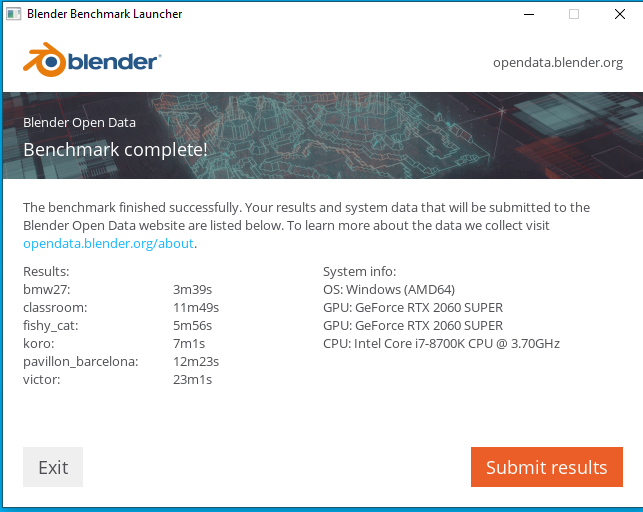 For the following chart, lower is better as the benchmark renders a scene multiple times and gives the results in minutes and seconds.
For the following chart, lower is better as the benchmark renders a scene multiple times and gives the results in minutes and seconds.  From the chart, the Blender benchmark performance is similar whether using 16GB DDR-3200MHz or 32GB of DDR4 3866MHz or 64GB DDR4 3000MHz. We played around with Blender and with Photoshop, and more RAM is better for pro apps; but this is not our area of expertise
From the chart, the Blender benchmark performance is similar whether using 16GB DDR-3200MHz or 32GB of DDR4 3866MHz or 64GB DDR4 3000MHz. We played around with Blender and with Photoshop, and more RAM is better for pro apps; but this is not our area of expertise
Our conclusion from synthetic benchmarking is that there is no performance disadvantage to having 32GB RAM at the same clockspeed as 16GB.
Higher-capacity RAM benefits
We note performance scaling from overclocking the RAM is quite small for game-related benching. The purpose of higher capacity RAM is for workstations and professional applications. Content creators, professional video and image editors, programmers, CAD, and other design software power users will benefit from having more RAM, especially in a workstation situation. Running out of system RAM drastically slows up projects as the PC than has to swap memory to disk, and RAM is always faster than the fastest SSD. Let’s take image processing as one example.
Photoshop image processing uses a lot of RAM since working with just one image may take hundreds of MB. And there may be dozens of versions of the same image in different stages that all need to be processed in parallel. Working with multiple images – each with multiple versions in stages requiring parallel processing – takes many gigabytes of RAM to keep all of the image processing in the RAM memory, and using 32GB RAM (or more) may be considered useful and usual.
Since RAM is significantly faster than disk – perhaps 10X faster than a SSD – active projects should always be able to entirely fit into system memory. Multiple images that may take minutes to process with 32GB or 64GB RAM may take hours to write to disk in an 8 or 16GB memory system because of the high volume of data. But for gamers, there isn’t a lot of need for more than 16GB of system memory. This may well change with the next generation of PC consoles, but “future proofing” now doesn’t make a lot of sense as DDR5 will likely be popular when memory-hogging new console ports to PC are released.
There are instances where a pure gaming PC may want to have more than 16GB of system RAM. Modders who aim for photo realistic games by using super high resolution textures may need more than 16GB. Streamers will generally want more than 16GB, and VR gamers may find that by using a Wireless adapter 5GB-6GB of memory may be used while just idling on the desktop! BTR will upgrade to 32GB DDR4 for our i9 PC.
Next, the gaming benchmarks and the summary charts followed by the conclusion.
Game Performance Results, Summary Charts, & Conclusion
Gaming Performance Benchmarks
Below is the summary chart of three games which appear to be sensitive to scaling by increasing CPU speeds and possibly by increasing memory clocks using a stock RTX 2060 SUPER Founders Edition.
The highest settings are used, and the benches were run at 1920×1080. Civilization 6’s built-in graphics benchmark uses frametimes but its AI benchmark measures the turn time in seconds – in both cases, lower is better. Anno 1800 is benched using OCAT and so the averages and the minimums are expressed in frametimes where lower is better. Grand Theft Auto V average/minimum results are given in FPS where higher is better.
These three games show varying degrees of regular incremental performance increases with faster RAM. Although the benchmarking margin of error may cloud the results, there is a trend showing that faster memory may increase framerates for certain CPU-dependent games.
Synthetic Summary Chart
Here are the Summary charts in one location.
Let’s head for the conclusion.
Conclusion and Verdict
We have seen that that running DDR4 at a faster clock speed produces performance gains and saves time with some tasks. In addition, some CPU-dependent games can benefit from faster system memory. We also note the importance of more than 16GB of system RAM for workstation and professional applications. However, there is no way that we can recommend 32GB of system RAM to a gamer who only uses his PC for gaming. If a gamer wants more than 16GB as a multitasker or a modder, than 32GB is a good option. The T-FORCE DARK Z DDR4 3600 2x16GB kit is $131.22 and $69.99 for the 16GB kit at Newegg.
Faster RAM benefits are mostly shown by memory intensive benchmarks and they will mostly translate to better productivity outside of gaming. If you are a gamer, buy faster memory and pick 2x8GB for gaming or 2x16GB if you multitask while gaming. So far, 32GB is not the ‘new 16GB’ for gaming. It doesn’t make a lot of sense for gamers to buy extra DDR4 now for ‘future proofing’ when DDR5 is not that far off.
T-FORCE DARK Z 2x16GB DDR4 3600MHz Kit
Pros
- The T-FORCE DARK Z 2x16GB DDR4 kit may be used for professional applications as well as for multi-taskers and used without any penalty compared with 2x8GB in a gaming PC.
- Our DARK Z review sample is fast, stable, and it overclocks multiple speed grades beyond its rated 3600MHz grade to 3866MHz at 1.4V.
- At stock, DARK Z it is nearly as fast as the XTREEM DDR4 3866MHz and it’s faster when overclocked
- DARK Z is conservative-looking with no frills, no large external heatsinks, and no RGB which allows it to easily fit in most motherboards even with large CPU air coolers
- Voltage tolerances may be set from 1.2V to 1.4V and even higher to allow for overclocking.
- DARK Z is competitively priced and it comes with a lifetime Team Group warranty.
Cons
- CAS 18 instead of 16
The Verdict
If you are a gamer with high quality components and who wants great performance plus you need to work with RAM-intensive applications or multi-task, then the Team Group T-FORCE DARK Z DDR4 3600MHz 2x16GB kit is an excellent choice as it is fast at stock speeds coupled with an overclocked CPU, plus it overclocks very well and is reasonably priced for the 2x16GB kit at $131.22 and at $69.99 for the 16GB kit at Newegg. If you are a Ryzen gamer, we highly recommend the faster 2x16GB DARK ZA kit for $119.99(!)
 We feel that the T-FORCE DARK Z 2x16GB DDR4 3000MHz Kit deserves BTR’s Editor’s Choice Award as a fast 32GB high-capacity kit that is also suitable for gaming. It’s ideal for gamers who also run memory intensive applications. And it is BTR’s choice for our own new flagship i9-10900K PC.
We feel that the T-FORCE DARK Z 2x16GB DDR4 3000MHz Kit deserves BTR’s Editor’s Choice Award as a fast 32GB high-capacity kit that is also suitable for gaming. It’s ideal for gamers who also run memory intensive applications. And it is BTR’s choice for our own new flagship i9-10900K PC.
Gamers who play modded games using ultra high textures may need 32GB of RAM or more. Gamers who stream while gaming or otherwise multitask will benefit from 32GB. VR gamers may also benefit. But for a pure gaming PC, 16GB is plenty for now and Team Group has plenty of choices at good prices. 32GB is not the new 16GB – yet.
Memory prices change daily so we suggest checking for sales to get the best bang for buck. Team Group has a special USA promotion for July with Newegg and a contest anyone can enter with three lucky winners – click on the banner for the contest details or here for a link.
Stay tuned. We are working on a Death Stranding DLSS 2.0 performance and IQ review for posting by the weekend and then we will head ‘Into the Radius’ for a S.T.A.L.K.E.R.-like VR game review early next week.
Happy Gaming!
